Link para o artigo original : http://ow.ly/ibUE50H5YGw
Climate Investment:
Positioning Portfolios for a Warmer World
By Steven Desmyter, Otto van Hemert, Ashok Kumar Muthusamy, Matt Goldklang, Edward Cole and Alex Preston
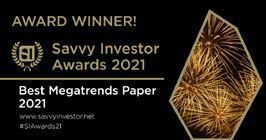
Awards and/or ratings are for information purposes only and should not be construed as an endorsement of any Man Group company nor of their products or services. Please refer to the websites of the sponsors/issuers for information regarding the criteria on which the awards/ratings are determined.
Contents
Introduction
Part 1: The Science of Climate Change
1. Climate Models
2. AR6
3. The Paris Agreement
4. Corporations, Regulation and Climate
Part 2: Investing in a Warming World
1. Physical Cost
2. Transition Costs
3. Stranded Asset Costs
4. Opportunity
5. Portfolio Management in a Warming World
Part 3: Sustainable Investing and ESG
1. The Rise of Sustainable Investing
2. ESG Ratings Firms and Frameworks
3. From ESG to Climate+
4. Environmental Regulation in the Investment Industry
5. Stewardship and Activism
6. What Securities are ‘Good’ for the Environment?
Authors
Bibliography
Introduction
Let us skip the pleasantries. This is not a document in which we will seek to justify action on climate – the evidence is clear, the need unquestionable. Nor is this intended as a marketing document, indicating how seriously we all take the issue – we have all read enough of that kind of self-serving material. Rather, this White Paper seeks to do something that we haven’t seen done elsewhere: to give a comprehensive and realistic overview of how the climate crisis has impacted financial markets, how the markets have responded, and the role that we believe the financial services industry has to play in the move to a carbon-neutral future. Throughout this document, we will prioritise facts and data over conjecture and opinion, seeking to do several very difficult things: to look with some degree of perspective at the present moment; to steer past the fluff and bluster to establish an unalloyed picture of what has been achieved and what is yet to be achieved; and to forecast both future developments and potential challenges for the industry as we move towards 2050 (and beyond).
We begin the paper with a comprehensive survey of the world of climate science. To understand the challenges and opportunities ahead, it’s necessary to grasp the terminology and methodology that climate scientists use to model potential temperature rise scenarios. In the opening chapters we will provide an in-depth guide to climate modelling and the various paths to net zero that are currently envisaged. We will outline the terms of the Paris Agreement, look at which countries have made which pledges regarding carbon reduction and how these are factored into the broader climate models. We will look in particular at the recently-released IPCC 6th Assessment Report (AR6) and its implications for the manner in which global heating is addressed.
The second section offers the reader an alternative slant on climate investment. Here we consider how climate will impact corporations and how investors might position their portfolios for a warming planet.(1) We look at how physical costs, transition costs and stranded assets will impact company balance sheets and P&Ls. We take the reader through an example of an energy firm seeking to realign its business model with carbon neutrality and suggest ways in which investors can pick between the winners and losers in this great generational transition. Even if the world hits its 2050 goals, there will still be some measure of global heating in the coming years and this will have significant implications for companies and markets. Less Developed Economies will suffer more, while there will be opportunities for those in more temperate and polar zones. Climate change will re-draw the global economic map and investors need to prepare their portfolios for this shift.
The final section of the paper focuses on the rapidlyexpanding world of climate-focused investment. Here we chart the rise of sustainable investment, ESG and green bonds. We seek to provide investors with a model for thinking about investing with a climate-focused mandate – given the varying metrics by which firm performance can be judged as far as sustainability goes and the wide dispersion between climate ratings from different data providers, how does one establish with any certainty whether an investment is genuinely climate-positive? Is ESG an accurate and useful proxy for climate investment? Where are the disjunctures between the ‘E’ in ESG and Climate Positive investing. We will look at European SFDR directives and how these are applied to funds. We then turn to the question of stewardship, attempting to outline a model for best practice when it comes to shareholder voting and engaging with company management on climate. We end this section with an attempt to outline our best estimates of the evolution of climate-focused investment across a variety of different asset classes.
This is a document that is about time and change, about how humans negotiate horizons and how, in extremis, scientific ingenuity and political will have been harnessed to address a crisis of unimaginable seriousness. It is perhaps too soon to say that we as a financial services industry can be proud of our contribution to the climate fight, but significant steps have been taken already and it feels like there is strong investor will to follow through on the promises made so far. We hope that you enjoy this, the third of our Client White Papers, and look forward to discussing it with you now and in a cleaner, greener future.
Part 1
The Science of Climate Change
What are climate models and how are they used to measure anthropogenic climate change?
What are Greenhouse Gases (GHGs) and how do they cause global heating?
How do scientists construct climate scenarios and how do they help us to ascertain the likely path of global temperatures?
What is the Paris Agreement and what will it mean for businesses?
Chapter 1 Climate Models
Key Points
-
-
-
-
-
What is the difference between climate and weather?
-
What is the Earth System and how do Climate Systems interact with it?
-
-
-
-
1.1 Introduction
The accuracy and sophistication of climate modelling is much like any other kind of modelling – it relies on credible and dependable data and it needs powerful computers to run multiple scenarios in order to establish the likeliest future paths for our climate. One of the things that has helped overcome climate change scepticism in recent years is the increasing reliability of climate models, not only in their ability to forecast the dire ramifications if action isn’t taken on carbon and other emissions, but also in the way they are able to show with great clarity the role that humans have played in global heating. In this chapter we will look at how climate models are constructed, how they are then used by climate scientists to establish potential scenarios for future temperature rises and what mitigating impact efforts to reduce emissions are likely to have.
Let us begin with the basics. A direct line can be drawn from weather forecasts to climate models. Weather forecasters use data and weather models to establish likely atmospheric conditions. The forecast takes into account humidity, temperature, air pressure, wind speed and direction, as well as cloud cover and other natural and man-made elements that could impact the hour-by-hour weather. These forecasts look out over a period of 10 days to two weeks and ascertain with both reasonable certainty and geographic specificity the likely pattern of weather in any one location. These individual localised forecasts are then combined to give a picture of the likely weather in a region and country.
Climate models essentially employ a similar process to weather models, although whereas weather looks for short-term patterns with a high degree of granularity, climate models analyse broader data over much longer time periods to establish average conditions over decades and centuries. Climate models also include processes that may not influence short term fluctuations in weather but are contributing to longer term climate change. These include ocean currents and melting glaciers, as well as the impact of human activity. Climate models take many thousands, even hundreds of thousands, of data points and run them through sophisticated iterations to simulate the impact on complex earth systems.
What is the Earth System?
The term ‘Earth system’ refers to Earth´s interacting physical, chemical, and biological processes.
The system consists of the land, oceans, atmosphere and poles. It includes the planet’s natural cycles — the carbon, water, nitrogen, phosphorus, sulphur and other cycles — and deep Earth processes.
Life too is an integral part of the Earth system. Life – human and other – affects the carbon, nitrogen, water, oxygen and many other cycles and processes.
The Earth system includes human society – our social and economic systems are now embedded within the Earth system. In many cases, human systems are now the main drivers of change in the Earth system.
1.2 The Science of Global Heating
-
What is Global Heating and how do Greenhouse Gasses (GHGs) cause it?
-
What are the major GHGs?
- What are dadiative forcings and how do they play into the construction of climate models?
Global heating is the long-term heating of Earth’s climate system observed since the pre-industrial period (before 1850) due to human activity, primarily the burning of fossil fuels, which increases heat-trapping greenhouse gas levels in Earth’s atmosphere. Global heating (or warming) is frequently used interchangeably with the term climate change, though the latter refers to both human- and naturally produced warming and the impact it has on our planet. It is most commonly measured as the average increase in Earth’s global surface temperature.

Earth’s greenhouse gases trap heat in the atmosphere and consequently increase global temperatures. The main greenhouse gases emitted by human activity are carbon dioxide (CO2), methane (CH4), and nitrous oxide (N20). Annual emissions of these three substances have respectively risen, as measured in billions of tons, from 14.8, 5.3, and 2.2 in 1970 to 36.1, 8.0, and 3.2 by 2014. CO2 is the least potent but nonetheless the most important greenhouse gas. It is released in massive and rising volume from the burning of fossil fuels (petrol, natural gas, coal) and land use (deforestation, slash-and-burn agriculture). More potent, but released in overall volume that is less impactful, is CH4, which is a by-product of livestock digestion, fossil fuel extraction, and the decay of agricultural waste. This is followed by N20, which is released by industrial activity and industrial agriculture. Methane is more potent immediately after it is released, but it decays faster (over one or two decades) than carbon dioxide (which takes around a century).
There are other harmful gases that contribute to global heating, including Fluorinated gases (F-gases) including hydrofluorocarbons, perfluorocarbons, sulphur hexafluoride and nitrogen trifluoride. These are powerful synthetic greenhouse gases that are emitted from a variety of industrial processes.
Greenhouse gases have different chemical properties and are removed from the atmosphere, over time, by different processes. Carbon dioxide, for example, is absorbed by so-called carbon sinks such as plants, soil, and the ocean. Fluorinated gases are destroyed only by sunlight in the far upper atmosphere.
How much any one greenhouse gas influences global warming depends on three key factors. The first is how much of it exists in the atmosphere. Concentrations are measured in parts per million (ppm), parts per billion (ppb), or parts per trillion (ppt); 1 ppm for a given gas means, for example, that there is one molecule of that gas in every 1 million molecules of air. The second is its lifetime—how long it remains in the atmosphere. The third is how effective it is at trapping heat. This is referred to as its global warming potential, or GWP, and is a measure of the total energy that a gas absorbs over a given period of time (usually 100 years) relative to the emissions of 1 tonne of carbon dioxide.
To establish patterns of climate change, scientists look at what is known as radiative forcing. There are natural forcings – changes in the sun’s energy output, the Earth’s orbital cycle, volcanic eruptions – and, increasingly, there are humancaused or anthropogenic forcings – the release of gasses that increase the amount of energy within the Earth system. Each greenhouse gas has its own radiative forcing and the combination of these forcings is largely responsible for global heating. Since the Industrial Revolution, radiative forcing has increased dramatically, a reflection of the impact of anthropogenic activity.
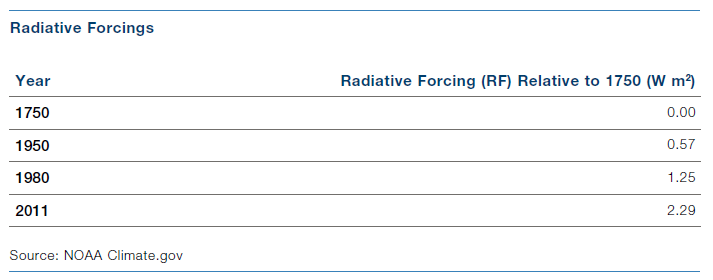
The table below shows the impact of different forcings on overall climate and the level of confidence with which each of these impacts can be stated.
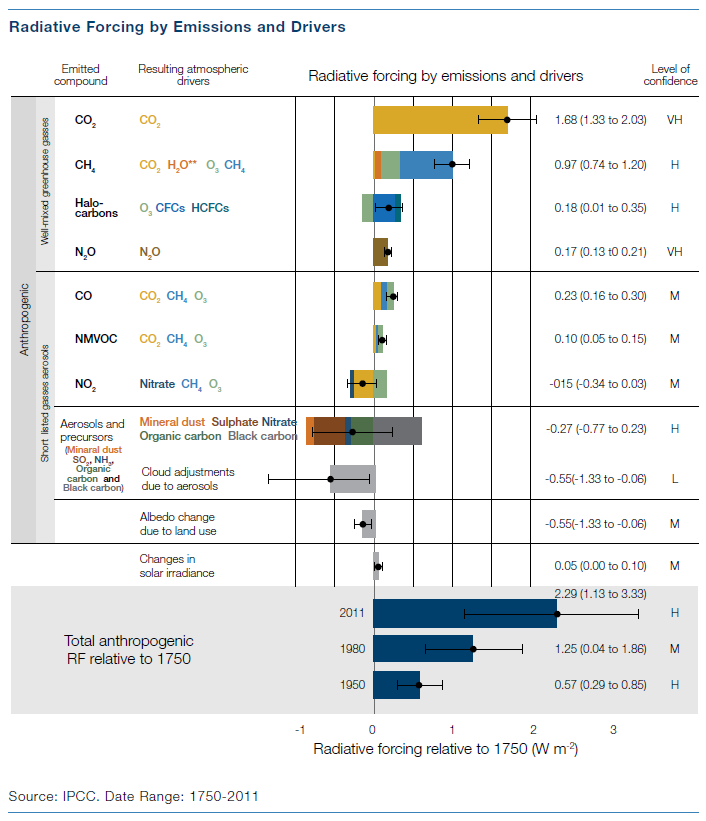
1.3 Building Climate Models
-
How to understand the findings of climate models.
-
Why do climate models take so long to run?
- The grid-based design of climate models.
- Different types of climate model.
It should be pointed out here that climate models are not a precise science; they do not show facts but rather indicate potential directions for climate. The further into the future they look, the less certain they are. This uncertainty sits behind many of the misapprehensions and issues surrounding climate models. If we understand them properly it is as indicators of change and potential paths of travel, which, in combination with other forecasting models and research, will give a range of possible outcomes for global temperatures and other climatological changes.
When building models climate scientists draw on a number of objective physical principles that underpin the Earth system regarding the transfer of energy and matter. These include Newton’s First Law of Thermodynamics, which says that energy cannot be created or destroyed, but only changed from one form to another; the Stefan-Boltzmann Law, which shows that the natural greenhouse effect maintains global temperatures 33C higher than they would otherwise be; and the Navier-Stokes equations of fluid motion, which characterise the speed, pressure, temperature and density of gases in the atmosphere and the water in the ocean.
These physical equations are converted into code in computer models, generally written in the somewhat archaic programming code Fortran. A single climate model can fill 18,000 pages of printed text. There are more than 40 global climate models currently in operation and they work by separating the Earth’s surface into a 2- or 3-dimensional grid of cells, usually between 600km and 100km in longitude and latitude (although, due to the curvature of the Earth, these will be smaller at the poles and larger at the equator). These grids are layered both horizontally and vertically across the surface of the Earth, down to the depths of the oceans and into the atmosphere.
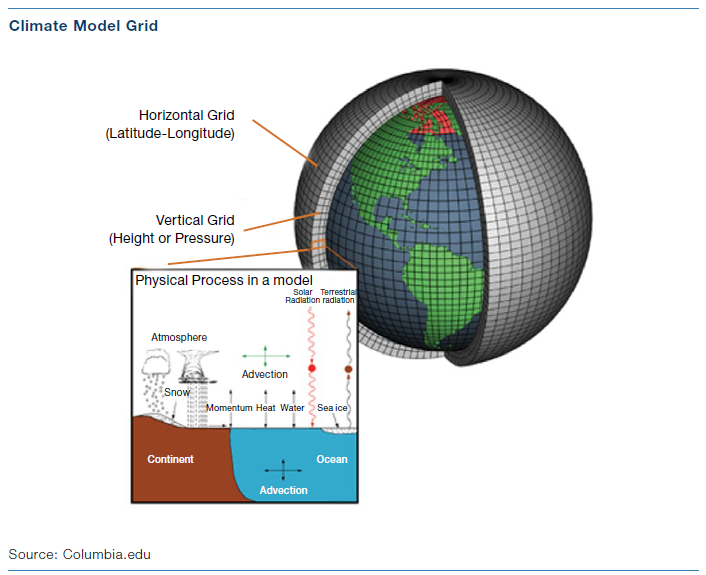
The model then calculates the state of the climate in each cell, establishing disparate elements such as pressure, temperature, humidity and wind speed. For processes that happen on scales that are too small to be captured by the grids (such as convection) the model uses ‘parameterisations’ to fill in these gaps.(2) These are essentially approximations that simplify each process and allow them to be included in the model. More recently, scientists have experimented with using different shapes for these grids, including cubed spheres and icosahedral grids. As a general rule, increasing the spatial resolution of a model by a factor of two will require around ten times the computing power to run the model in the same amount of time.
Every model is a series of compromises between accuracy and the amount of computer power/time required to run the model. The size of each individual grid is only one element that can be altered to provide a more accurate/swifter result. Once the grids have been laid out, the next stage is to calibrate the frequency with which the model calculates the state of the climate system – this is known as the ‘time step’ process. Depending on the aims of the climate model, each time step can be set at minutes, hours, days or even years. Smaller time steps give more accurate results, but at the expense of requiring greater computer power.
Once climate models are constructed, they are hindcasted, running the model backwards against recorded data to test for accuracy. Scientists are then able to adjust the models based on how closely they mirror observed data. Once a model performs well in hindcasting, its results are assumed to be valid, and it is then used to create simulations of future climate scenarios.(3)
1.4 Climate Scenarios
-
How do scientists and policymakers use climate models to inform climate scenarios?
-
How should we seek to understand climate scenarios and pathways?
- How do climate scenarios drive carbon budgets?
Forecasting climate is a science, but it’s also an art. Any climate model is only as good as the scenarios it works with – these scenarios can be thought of as narratives around the future path of human development. This means that scientists need to estimate the growth of populations, the way land is used, the evolution of economies and, crucially, the extent to which technology will help humans to mitigate the impact of detrimental gas release.
In 2000, the Intergovernmental Panel on Climate Change (IPCC) issued its Special Report on Emissions Scenarios (SRES), constructing four scenario families to describe a range of possible future conditions. Referred to by letter-number combinations such as A1, A2, B1, and B2, each scenario was based on a complex relationship between the socioeconomic forces driving greenhouse gas and aerosol(4) emissions and the levels to which those emissions would climb during the 21st century. Climate scientists used this data to produce estimates of how much CO2 the world can continue to emit and still keep global average temperature rise to no more than 1.5°C, 2°C or 3°C above pre-industrial levels. These are known as carbon budgets.
For each temperature limit the IPCC produced three specific budgets, each corresponding to a different probability of staying below that limit: 66%, 50% and 33%. The chart below, from Carbon Brief, shows how many years are left of current emissions before we breach the 66% budget of a 1.5°C rise, according to a variety of different models.
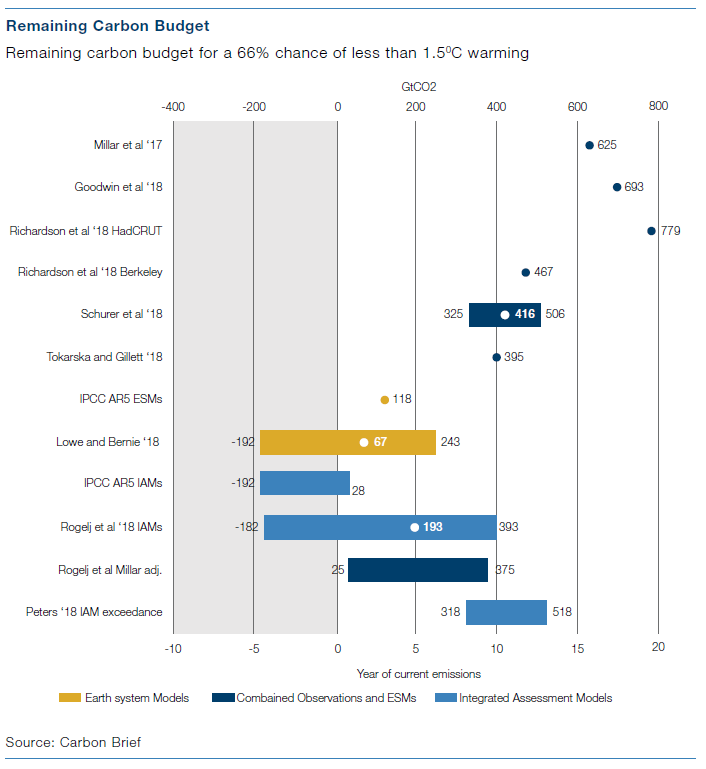
In a 2017 paper in the journal Nature Geoscience entitled ‘Emission budgets and pathways consistent with limiting warming to 1.5 °C’, the University of Exeter’s Richard Millar and a group of fellow academics attempted to establish as definitively as possible the remaining global carbon budget that would keep temperatures below the 1.5°C level. The findings of the study were highly controversial, in that they suggested a much greater budget than had previously been considered, with around 15 years of current usage left (this was 5x higher than previous IPCC estimates). While many took issue with Millar’s findings at the time, subsequent studies have largely supported the view that we may have more carbon budget than has been suggested by IPCC models. However, even taking into account Millar’s more optimistic estimates, there is still a vanishingly small window in which we have an opportunity to limit the damage of climate change.
There were subsequent updates to the IPCC SRES, each being named an Assessment Report and concentrating on a different subset of the factors driving climate change. The most recent of these, AR6, was released in 2021. Alongside AR6, we also saw the latest iteration of the Coupled Model Intercomparison Project (CMIP), a multinational effort to improve the accuracy of climate models by comparing outputs from multiple different models.
Different types of Climate Model
Most climate models can be separated into four distinct types: energy balance models, intermediate complexity models, and general circulation models.
Energy balance models are the simplest and oldest form of climate model. They forecast climate changes using Earth’s energy budget. Forecasters look at elements including surface temperatures from solar energy, the albedo effect (reflectivity), and natural cooling as the Earth emits heat back out into space. Essentially, scientists calculate the difference between the amount of energy coming into the atmosphere and the amount going out. This establishes changes in heat storage. These models are essentially one-dimensional (or even zero-dimensional, meaning that they treat the Earth as a homogenous whole).
Radiative Convective Models simulate the transfer of energy through the height of the atmosphere – for example, by convection as warm air rises. Radiative Convective Models can calculate the temperature and humidity of different layers of the atmosphere.
Intermediate complexity models are similar to energy balance and radiative convective models, but they include Earth’s geographical structures in their calculations: land, oceans, and ice features. These geographical features allow intermediate complexity models to simulate large-scale climate scenarios such as glacial fluctuations, ocean current shifts, and atmospheric composition changes over long timescales. Intermediate complexity models describe the climate with less spatial and time-specific detail, so they are best used for large-scale and lowfrequency variations in the earth’s climate system.
General circulation models are the most complex and precise models for understanding climate systems. These models essentially combine the two previous models to take into account information regarding the atmospheric chemistry, land type, carbon cycle, ocean circulation and glacial makeup of the isolated area. These models tend to use smaller grids in order to give more accurate forecasts. Because of this, and the greater complexity of the data processing required, general circulation models can take several days to several weeks to run.
Chapter 2 AR6
Key Points
-
-
-
-
-
Assessment Report 6 is the IPCC´s most recent update, indicating how far the world still has to go to control global heating.
-
The tone and substance of the report marked a significant change from previous reports, being both more certain and more severe in the degree to which humans are implicated in global heating and the need to take urgent action to redress it.
-
Shared Socioeconomic Pathways (SSPs) seek to give a narrative to climate pathways, showing how we reach outcomes, both positive and negative.
-
-
-
-
August 2021 saw the release of the IPCC’s Assessment Report 6, with significant press and public attention generated around the key findings of the report. The Secretary-General of the UN, António Guterres, called the report a ‘code red for humanity.’ AR6 saw a distinct change in both tone and substance of the IPCC’s communications. The headline was clear – there is no longer room for doubt about humanity’s role in global heating and time is running out for meaningful action to be taken. In the words of the report, ‘It is unequivocal that human influence has warmed the atmosphere, ocean and land. Widespread and rapid changes in the atmosphere, ocean, cryosphere and biosphere have occurred… Global surface temperature will continue to increase until at least the mid-century under all emissions scenarios considered. Global warming of 1.5°C and 2°C will be exceeded during the 21st century unless deep reductions in CO2 and other greenhouse gas emissions occur in the coming decades.’
Other key takeaways are:
-
A greater understanding of the regional variability of climate change; granular pictures of changes in temperature, precipitation and sea level rises in different locations globally.
-
Sea level rises have been established as likely averaging 0.5-3m by 2100, although this may increase to between 3-7m.
- The report quantifies climate sensitivity as between 2.5 °C and 4 °C for each doubling of carbon dioxide in the atmosphere.
- Extreme weather events are very likely to increase globally and particularly in specific regions such as the Sahel, India and South American monsoon areas.
AR6 adjusted scenario modelling to take into account both the greater visibility of data and improvements in technology – both the modelling capabilities of computers and the various technologies helping to drive the world towards a lowercarbon future. Previously, the IPCC used two distinct forms of climate scenario, Representative Carbon Pathways (RCPs) and Shared Socioeconomic Pathways (SSPs). SSPs chart socioeconomic pathways whereas RCPs measure physical forcing. In previous assessment reports there was a matrix of SSPs and RCPs. For example, there could be an SSP2/RCP4.5 or SSP3/RCP6.0 world. In recognition of the fact that it is impossible to separate socioeconomic activity from the forcings associated with this activity, the IPCC has now retired RCPs and focuses solely on SSPs.
SSPs give a best estimate and range of very likely outcomes for global heating in three distinct time periods – 2021-2040, 2041-2060, 2060-2100. SSP 1-1.9 is the pathway associated with maintaining temperatures below the crucial 1.5-degree level.
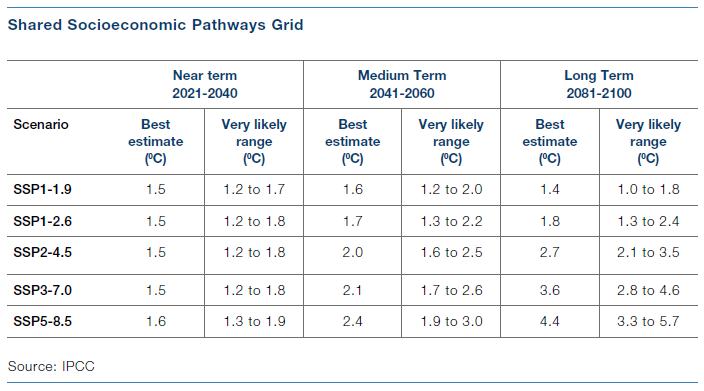
SSPs seek to provide narratives that explain the potential path of carbon emissions from a societal and economic standpoint, taking into account both concrete elements such as population density and GDP per capita and more nuanced, abstract ideas, like the extent to which countries are prepared to work together to tackle climate change, whether technology is able to address global heating and how much the move to a green economy is able to prompt a levelling-up of less developed nations. SSPs also employ a more sophisticated and nuanced understanding of the interplay of different emissions, with a greater focus placed on the role of methane in global heating as well as the mitigating impact performed by aerosol emissions(5). This interplay of the two dominant environmental crises of recent years – global heating and ozone destruction – is complex and nuanced, as can be seen from the chart below.
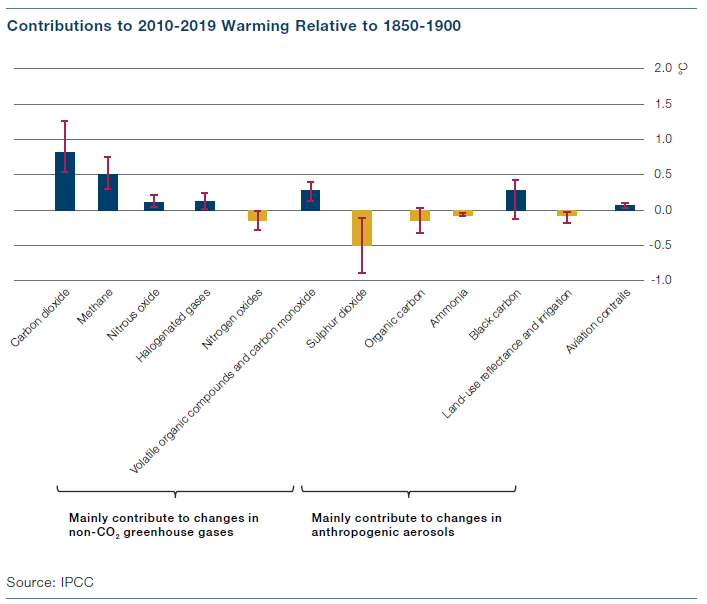
The SSPs provide a more detailed and yet intuitive picture of the paths of global heating associated not only with emissions but crucially with the geopolitical and economic backdrops against which these emissions are released. The chart below shows the emission pathways associated with these SSPs.

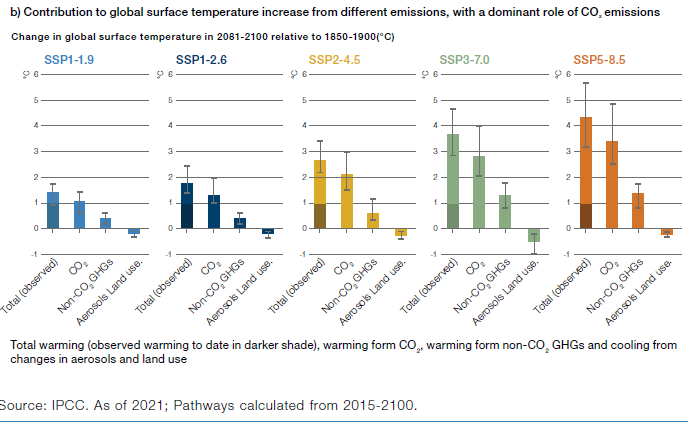
The IPCC is now working to pull together a Synthesis Report, which will represent the final element of the AR6 process and will be released in September 2022. This Synthesis Report will bring together all the different aspects of AR6 and will seek to provide further guidance on the action needed to address climate change. The first section of the Synthesis Report, ‘Current Status and Trends’, covers the historical and present period. The second section, ‘Long-term Climate and Development Futures’, addresses projected futures up to 2100 and beyond. The final section is ‘Near-term Responses in a Changing Climate’, considers current international policy timeframes, and the time interval between now and 2030-2040. The Synthesis Report will be viewed in draft at the United Nations Climate Change Conference (COP26) in Glasgow in October and November 2021. We should expect the release of this report to garner significant coverage and further sharpen the pace and intensity of action on climate change.
The next iteration of the IPCC’s process, AR7, will be released in 2028.
Chapter 3 The Paris Agreement
Key Points
-
-
-
-
-
The Paris Agreement was signed in December 2015 by 196 countries at COP21.
-
It is the most widely-accepted and binding global climate agreement to date.
-
It has significant implications for the fianacial services industry.
-
-
-
-
Looking at the Shared Socioeconomic Pathways scenarios for climate change modelling, one thing is immediately clear: addressing the challenges of climate change requires globally coordinated action. It will not be enough for developed nations to go it alone, or for there to be any consideration of markedly different approaches to tackling the crisis. Paris provided a clear blueprint for coordinated global action and yet it also highlighted the challenges facing the international community when it comes to the unique issues presented by climate change. As the SSPs make clear, it’s impossible to disentangle the specific goals of carbon emission reduction from other socioeconomic challenges, such that any attempt to address climate change must necessarily also take into consideration the global imbalances of wealth and development that mean that different countries are at different stages along the path to dramatically reduced carbon emissions and are each more or less able to bear the cost of transitioning.
Serious efforts to limit global heating began with the Rio Earth Summit in 1992, followed by the Kyoto Protocol of 1997. The latter issued legally-binding obligations for developed nations to reduce their carbon emissions in the years 2008-2012. The Doha Agreement covered the years 2012-2021. The US did not ratify the Kyoto Protocol, while Canada renounced it in 2012. All 37 other ‘Annex 1’ countries that ratified the Protocol met their obligations – essentially the EU and EEA, Australia, New Zealand, Ukraine and Japan.
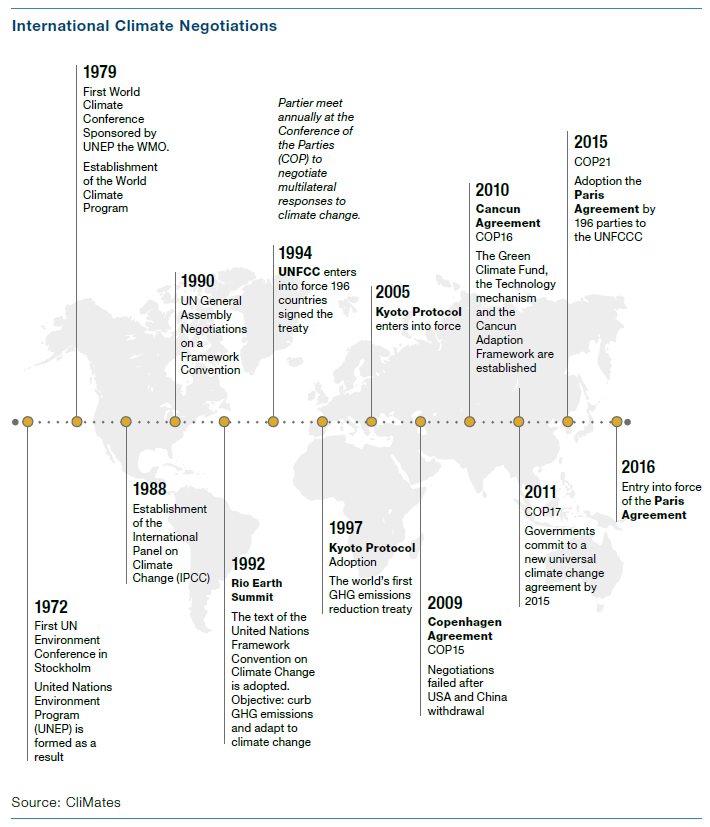
The Paris Agreement is the fruit of decades of work by governments and nongovernmental agencies to establish a roadmap towards a future in which global heating is kept below levels which would be severely damaging to the planet as a whole. It is a legally binding international treaty that was adopted at the COP 21 in Paris, on 12 December 2015 and entered into force on 4 November 2016. The goal of the agreement is to limit global warming to ‘well below 2, preferably to 1.5 degrees Celsius,’ compared to pre-industrial levels. In order to achieve this longterm goal, countries have agreed to begin to move towards carbon neutrality as swiftly as possible, with a general goal of achieving a climate-neutral world by 2050. While the US briefly withdrew from the Agreement under the Trump Presidency, it has now re-ratified, meaning that the vast majority of the globe now falls under the aegis of the agreement (only Iran and Turkey remain outside the accord as far as major polluters go).
3.1 The Mechanics of the Agreement
-
Nationally Determined Contributions (NDCs) were submitted by countries in 2020, showing the path each intended to take to achieve compliance with Paris Agreement goals.
-
There remains some way to go for many countries in order to meet the requirements of the Paris Agreement.
- There is an ‘ ambition mechanism’ built into the NDCs, such that targets will become more testing as time goes on.
The mechanism for achieving this goal is a series of increasingly aggressive 5-year plans, each of which has been scrupulously designed using the best available science with the aim of transforming the global economic and social landscape. Countries were required to submit their Nationally Determined Contributions (NDCs) in 2020, outlining how and when they will reduce greenhouse gas emissions in line with Paris Agreement goals. The NDCs also outline the steps each country will take to adapt to the challenges of a warmer world.

Alongside the NDCs, countries had to set out non-binding development plans that establish priorities and strategies for ensuring that emissions are kept low over the long-term.
The NDCs will be monitored via a series of ‘Global Stocktakes’ every five years that measure the extent to which goals are being met. Article 13 of the Paris Agreement articulates an ‘enhanced transparency framework for action and support’ that establishes harmonized monitoring, reporting, and verification (MRV) requirements. Both developed and developing nations must report every two years on their mitigation efforts, and all parties will be subject to technical and peer review.
Different countries have approached the NDC process in different fashions. It’s important to note that, according to the Climate Action Tracker, only two countries’ NDCs are currently adequate to meet the 1.5-degree target – The Gambia and Morocco – while six countries – India, Bhutan, Philippines, Kenya, Costa Rica and Ethiopia – hit the 2 degree target. At the other end of the scale are countries like Turkey, who have not ratified the Agreement, and Russia, Saudi Arabia, Ukraine, and Argentina, whose NDCs are viewed as woefully insufficient.
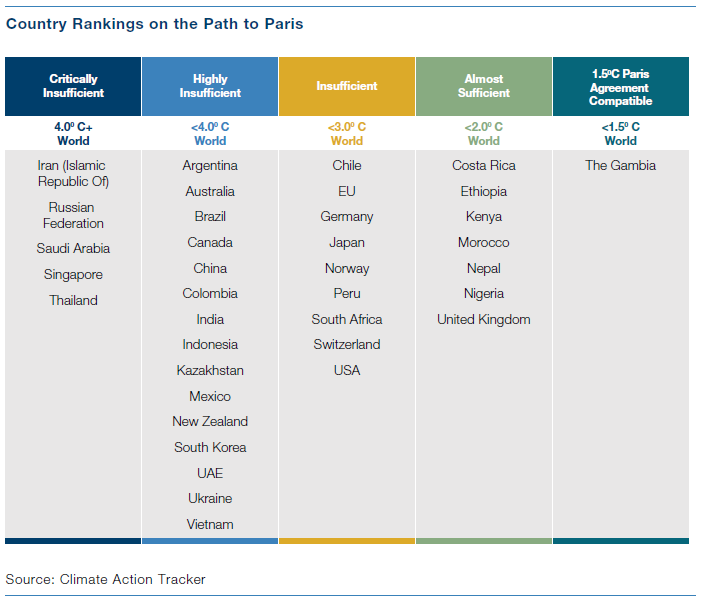
It’s important to recognise the accretive and ratcheting nature of the NDCs, and the in-built (some would say optimistic) momentum that is anticipated to develop as the path to 2050 progresses. As it stands, the pledges made by countries in the Paris Agreement will not keep global heating below 1.5 degrees (or even, for that matter, 2 degrees)(6), but it is hoped that the ambition mechanism will see an increasing level of impetus twinned with further technological advances to drive more substantial gains in the latter years of the timeline.
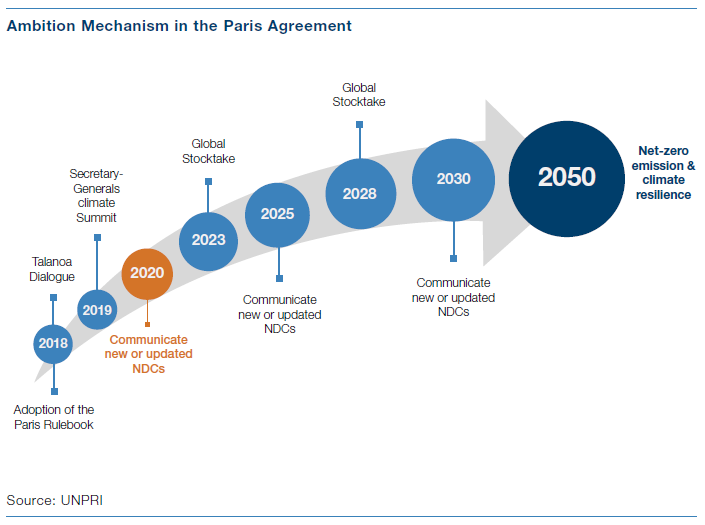
3.2 Green Finance in the Paris Agreement
-
Financial services will have a key role to play in the move to a zero-carbon world.
-
The Paris Agreement is crucial in that it recognizes the need for developed nations to help less-developed nations meet their Paris Agreement goals.
While the Kyoto Protocol only addressed developed nations, the Paris Agreement’s greatest challenge and – thus far – greatest success has been in bringing on board less developed nations. As such, developed nations have had to agree to support those less wealthy states who are both less able to pay for the transition to carbon neutrality and often more exposed to the depredations of a warmer world.
Developed nations have initially agreed to provide $100 billion each year to less developed nations to help them meet the cost of transitioning to a low-carbon future. This figure will be re-assessed (and likely increased) in 2025. The financial side of the Paris Agreement will largely be channelled through the UN’s Green Climate Fund, although there are a number of other private and non- governmental organisations that will help disburse the funds. One of the key areas of debate here is in how funds are spit between mitigation and adaptation. There has thus far been a heavy preference for spending money on mitigation, such that there has been significant focus in recent years on encouraging adaptation planning, particularly for those less-developed nations most at risk from climate change.
From green bonds to climate-related securitisation and factoring, the financial services industry will play a central role in helping countries structure and finance the transition to a zero-carbon world. There will be increasing interaction between public and private institutions as the cost and requirements of decarbonising become clear.
The question of who pays for climate-related environmental damage was a central part of the Paris Agreement negotiations. Even in the event that global heating is kept below the 1.5-degree level, there will still be significant heating in certain regions and more regular and severe extreme weather events. Previously loss and damage had been viewed as part of adaptation, but it is now recognised as a separate pillar of the Paris Agreement. Already agreed is a $420m climate risk insurance fund provided by the G7 and the design and implementation of a Climate Risk and Early Warning Systems (CREWS) Initiative. The Agreement has further undertaken to adapt the Warsaw Mechanism, a model for addressing loss and damage that expired in 2016, better to reflect the disproportionate burden borne by less developed nations when it comes to climate risk.
While the later chapters of this paper will explore the specific investment implications of the move to a carbon-neutral world (and the concomitant considerations of the economic repercussions of the inevitable global heating), it’s worth noting that the Paris Agreement is already having a material impact on corporations (and their investors). In the first case of its kind, Milieudefensie et al vs. Royal Dutch Shell in May 2021 saw the oil company, the world’s 9th-highest corporate polluter, stand trial in The Hague for the limited nature of its climate pledges (Shell had stated in 2014 that it believed that the Paris targets were unattainable and did not plan to change its business model away from oil and gas; with the adoption of the Paris Agreement, Shell set a handful of limited emissions reduction targets).
In its ruling, the court found Shell’s current sustainability policy to be insufficiently ‘concrete’, and that its emissions were greater than that of most countries. Due to these factors, the court ordered that Shell must reduce its global emissions by 45% by 2030 compared to 2019 levels; the reduction targets include emissions from its suppliers and buyers. The court declared the order provisionally enforceable, meaning that the order has immediate effect, even if one of the parties appeals the ruling (which Shell has said that it intends to do).
Chapter 4 Corporations, Regulation and Climate
Key Points
-
-
-
-
-
Companies will increasingly face significant regulation related to climate change.
-
What climate pledges have been made and how will companies be held to these pledges?
-
What are the various scopes of emissions that will be monitored?
-
-
-
-
Corporations are increasingly finding themselves pressured from a variety of different angles when it comes to sustainability. We will outline later in the paper our thoughts about stewardship and activism, but it’s worth briefly considering this from the company’s point of view. Firms are not only having to deal with a shareholder base that is both increasingly vocal in the face of backsliding on ESG targets and increasingly unwilling to invest with firms that do not prioritise sustainability and other non-financial goals; governments are also imposing ever-stricter regulations on corporations, and it is clear that, in particular, firms domiciled in Scandinavia, Benelux and Germany are having to meet ever-more-stringent emissions standards from local regulators. Furthermore, there is international pressure on firms that are seen to be polluting less developed nations in carrying out their operations. Finally, and perhaps most importantly, public opinion now seems to be firmly on the side of sustainability, and there are more avenues than ever to let a company know publicly that you disapprove of its methods. An example of a successful campaign waged largely on social media and in the press is the move to limit deforestation by palm oil corporations. While it’s a battle that is far from won, US food giant Cargill recently pledged to ensure none of its plantations contributed to deforestation.
We are increasingly seeing corporations making the kind of climate pledges that we traditionally saw from countries. Where these pledges are limited or not sufficiently robust, companies have been put under pressure from both regulators and shareholders. This has particularly been the case for the oil and gas industry, where we have seen the Shell case mentioned above and also significant pressure brought to bear on Exxon. It’s clear why this is the case: the products (in a broad sense) of just 100 private and state-owned fossil fuel companies were linked to 71% of global industrial greenhouse gas emissions since 1988.
It is not only the oil and gas industry that is under pressure, however. From fast fashion retailers to mining companies to agriculture, companies are having to radically rethink their business models in the wake of the rise of the sustainability movement. According to a recent paper by the University of Oxford called ‘Taking Stock’, around a fifth of the world’s largest 2,000 firms have made some form of net zero pledge, a figure that has risen significantly in the past few years. Of these, the majority are 2050 targets, with an increasing minority targeting 2030.
Tech companies have perhaps some of the most far-reaching goals. Last year, Microsoft pledged to be ‘carbon negative’ by 2030, meaning it would remove more carbon from the atmosphere than it emits. By 2050, it aims to have compensated for all of its historical emissions through carbon removal projects. Apple says its products and supply chain will be carbon neutral by 2030 and Google has committed to be powered exclusively by renewable energy by 2030 and claims it has already wiped out its carbon footprint by offsetting emissions.
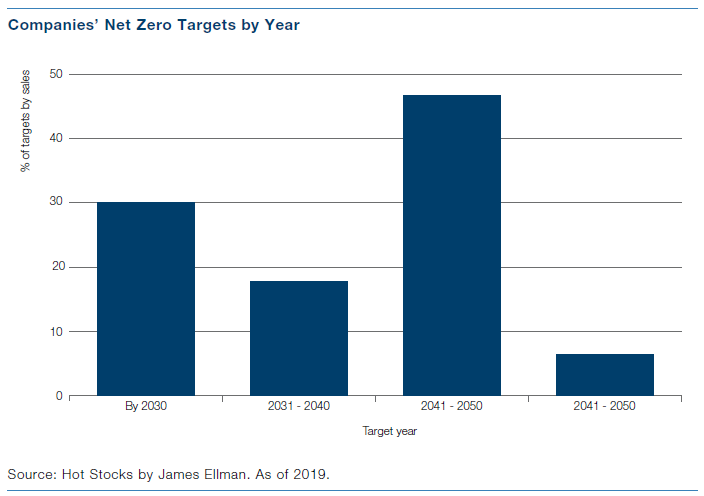
Large numbers of companies, including consumer-facing firms such as Ikea, PepsiCo and Levi’s, are also signing up to the Science-Based Targets initiative (SBTi), which helps companies calculate emissions targets aligned with the Paris agreement ambition of 1.5°C. More companies have signed up in the first half of 2021 than in the whole of 2020. An SBTi analysis of 338 large companies with science-based pledges found they had reduced combined emissions by 25% between 2015 and 2019.
Often, you will hear reference to different Scopes of emissions in discussions of environmental regulation. Greenhouse gas emissions have been categorised into three groups or ‘Scopes’ by the most widely-used international accounting tool, the Greenhouse Gas (GHG) Protocol. Scope 1 covers direct emissions from owned or controlled sources. Scope 2 covers indirect emissions from the generation of purchased electricity, steam, heating and cooling consumed by the reporting company. Scope 3 includes all other indirect emissions that occur in a company’s value chain.
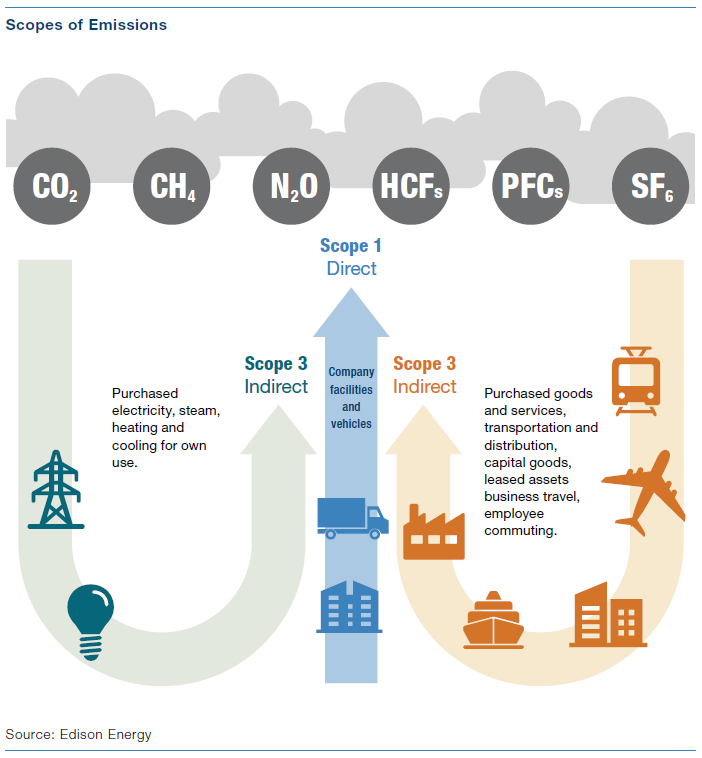
Part 2
Investing in a Warming World
The world is getting warmer; even if we act now, we must still prepare for a hotter world.
This will have significant implications for investors as they consider the future asset mix of their portfolios.
Companies will have to think about both the physical and transition costs they will face, as well as understanding which assets they currently carry on-balance sheet that may be rendered valueless by climate change.
Introduction
If there was one message that rang clear from the IPCC’s AR6, it was that we must as a planet prepare for temperature rises. Even should we manage to achieve the most ambitious targets of the Paris Agreement, there will still be global heating to contend with, and this heating will be unevenly distributed across different regions. The AR6 report indicated that all regions should prepare for rising temperatures, heavy rainfall and drought. If we manage to keep to around 1.5-degree warming from pre-industrial levels, we will still see rising seas and growing deserts, will still see some areas of the planet become more or less uninhabitable. Arid areas in the tropics from India to Arabia to the Sahel will see temperatures rise on average by 5-7 degrees annually. India, for instance, will see average temperatures rise from 30 degrees to 35 degrees. Within the country, this divergence will be even more extreme, with some areas seeing temperatures regularly exceeding 40 degrees. And this is the best-case scenario.
Using the IPCC’s Shared Socioeconomic Pathways and applying SSP 1-2.6, by which global mean temperature increase stabilises around 1.8-2C by end of century, we see a picture of global temperatures that is both more troubling and more divergent. While some parts of the world will benefit from these rising temperatures – meaning that, for instance, sea freight will be able to pass to the north of Russia, dramatically reducing journey times from Northern Europe to Japan; parts of Canada and Russia that were previously too cold for viable economic activity will be habitable – most of the planet, and particularly less developed nations, will suffer. Once we reach more extreme climate pathways, temperature rises are widespread and uncontrolled, bringing with them catastrophic weather events and drought.
It may seem that 1.5 or even 2 degrees of warming does not sound hugely significant. We experience temperature fluctuations far larger than this in the course of a single day. But it’s important to point out that temperatures during the last ice age, when the polar caps crept down to cover all of Ireland and Poland, as well as large swathes of Britain and Germany, temperatures were only 6 degrees lower than they are now. A small change in mean temperatures can make an enormous difference. The heatwave that struck the Pacific Northwest in the summer of 2021 was statistically impossible without the 1.2 degrees of warming we have experienced.
We believe that investors should be preparing their portfolios for a warming future. This is not to say that we should give up on efforts to mitigate climate change: far from it. Rather, we believe that it ought to be possible to fashion an investment strategy that is both ethical, sustainable, and future-proofed against the inevitable impact of global heating. We are only at the very beginning of what will be a multicentury narrative surrounding the intersection of asset management and climate change. If we as an industry are going to survive and thrive in this new era, we need to recognise that even if we manage to achieve all our aims in terms of cutting carbon emissions, we will still have a warmer world at the end of this century than we had when most of the models and concepts that dominate our investment practices were originated. We need to know what impact a changing climate will have on the firms we invest in and how we can act to shape our portfolios so that they are prepared for what lies ahead. Climate change will henceforth be an integral part of valuing any company.
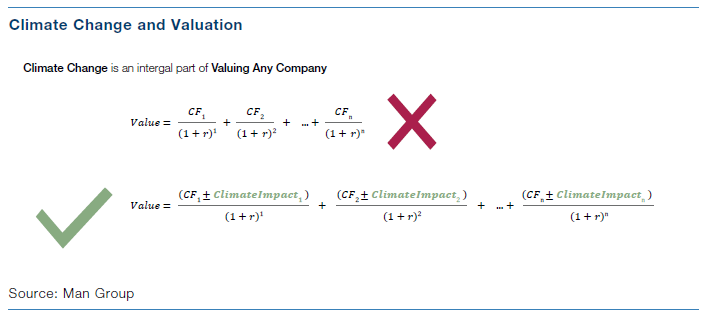
We will discuss in this part the impact of operating in a warming world on the way investors should think about asset selection in their portfolios. However, unlike in the previous chapters in this paper, we will not look at specifically green or sustainable investments, but rather at the way that global heating will necessarily shape the business models of all corporations in all countries. We will consider four areas in particular:
-
Physical Cost: the way companies are impacted by climate change will largely be a function of where they operate. Those firms whose operations are based in areas that will see either a significant increase in temperatures or a significant increase in extreme weather events will have to factor the cost of these increased risks into their business models.
-
Transition Cost: companies will have to meet the cost of transitioning to a lowcarbon economy. For some, this will be manageable, for others, it will require a wholesale alteration of their business models. Companies will have to meet increased regulatory demands and there will be an increased cost of capital for those companies falling behind in the move to net-zero.
- Stranded Assets Cost: the balance sheets of many of the world’s energy companies, utility firms and mining companies are currently carrying assets whose valuations do not correctly reflect the impact of climate change. We have said above that global heating must now be thought of as a vital component of company valuation and this is an area that we believe will see increasing focus as we move through the next decade. 60% of oil and gas reserves and 80% of coal reserves will remain unused if we are to meet climate goals of maintaining warming below 1.5 degrees.
- Opportunity: while some firms will struggle and even disappear because they fail to adjust to the realities of global heating, others will thrive. We view opportunities as arising from a variety of locations here – both green securities (which we have covered above), but also companies in legacy sectors whose management teams rise to the challenge of transitioning to low-carbon business models, and firms operating in areas that will see benefits from global heating, such as shipping firms able to use new routes and those based in regions of Russia and Canada that were previously too cold for economic activity to flourish.
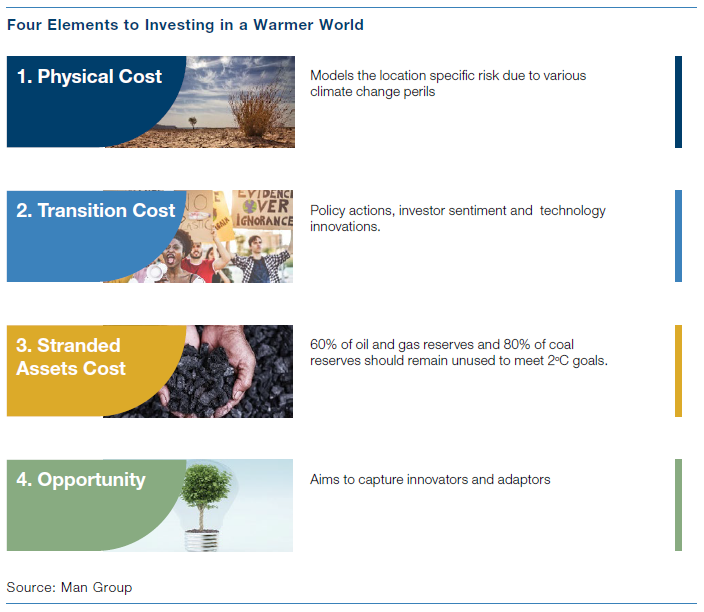
For each of these areas, we will illustrate our thoughts with the example of CoalCo, a fictional coal mining company. This will permit us to explore in detail the ramifications of the move to zero- carbon on a (fictional) firm caught in the crosshairs of the green revolution.
One final comment when it comes to the material and analysis presented here: we believe it’s crucially important that the real cost of climate change is clearly established and visible to the markets. This narrative is something that the TCFD pushes hard: that once markets come to understand the potential costs of climate change, they will recognise that the cost of mitigation is relatively low in comparison. This idea is outlined at length in an excellent paper by Johannes Stroebel and Jeffrey Wurgler of the NYU Stern School of Business entitled ‘What Do You Think About Climate Finance?’ In the paper, the researchers interviewed 861 finance professionals, economists and other practitioners to establish current thinking on the financial industry’s response to climate change. One element of the paper that is of particular relevance here is the fact that respondents believed by an overwhelming margin that current asset prices underestimate the real cost of climate change and that global warming poses an existential threat to the investment industry.
Chapter 1 Physical Cost
Key Points
-
-
-
-
-
Physical cost consists of revenue and operational risks.
-
The cost to a company is dictated by what industries and regions they operate in.
-
Climate change will deepen global inequalities and reduce global GDP.
-
-
-
-
The Physical Cost of the move to a zero-carbon world is calculated by looking at the way that several location-specific drivers feed into a company’s operations. We might think of these drivers as two separate classes of risk – revenue risk, which calculates the change in GDP growth for each company’s key markets and how these will impact demand, and operational risk, which will look at how various elements of a warmer world will impact a company’s business practices. This combines the condition and supply of the labour force, the demand for, and cost of, energy, and the impact of extreme weather events on a company’s operations.
1.1 Revenue Risk
The chart below shows how economic activity changes under a variety of different temperatures. We put together this chart inspired by a paper in Nature by Burke, Hsiang and Miguel at Stanford’s Department of Earth Sciences entitled ‘Global Non-Linear Effect of Temperature on Economic Production.’ The chart illustrates that there is a ‘sweet spot’ temperature for economic activity – around 13 degrees – with productivity gradually declining as temperatures rise or fall from this point. Hsiang et al’s paper makes clear that this relationship holds for both developed and less developed nations and has been backtested to 1960 across agricultural and non-agricultural activity. The paper was the first to establish an unequivocal linkage between temperature and economic activity and concluded that ‘unmitigated’ global warming would reduce global GDP by around 23% by 2100 and would significantly widen income inequality, with developed nations seeing less impact than less developed nations due to the unequal distribution of rising temperatures.
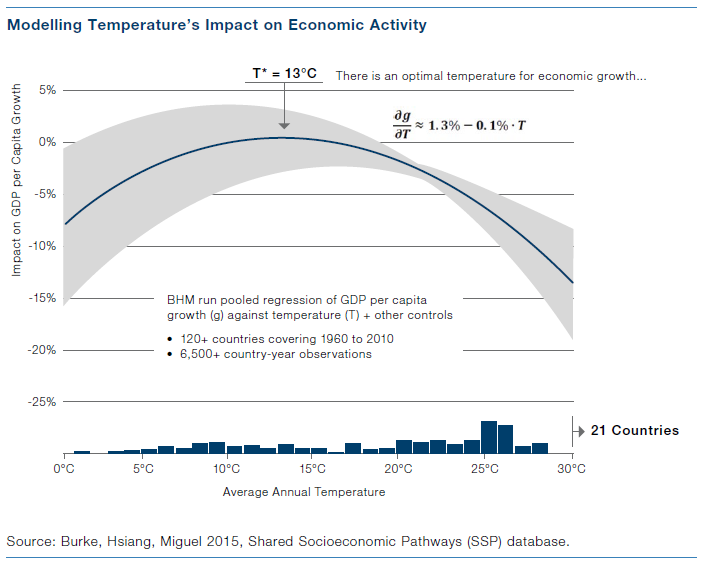
The most compelling analysis of the relationship between GDP growth and temperature comes from a paper by Burke et al. in Nature entitled ‘Global nonlinear effect of temperature on economic production.’ This paper contends that, across both developed and less developed countries, productivity declines significantly at high and low temperatures. The relationship, they claim, is globally generalizable, unchanged since 1960, and apparent for agricultural and nonagricultural activity in both rich and poor countries. These results provide the first evidence that economic activity in all regions is coupled to the global climate and establish a new empirical foundation for modelling economic loss in response to climate change. The paper suggests that, given continued unmitigated climate change, global incomes are likely to decline by around 23% by 2100 as a result of the relationship illustrated in the chart above. What is clear is that, given the current distribution of the global population and presuming that the data above hold true, rising temperatures may lead to either a significant reduction in productivity or mass migration away from places that have become uninhabitably hot to more temperate regions away from the equator.
The three maps below are constructed using the SSP1-2.6 pathway, by which global mean temperature increase stabilises around 1.8-2C by end of century. The first map shows that, as discussed above, global average temperatures will continue to rise precipitously and unevenly, with heating concentrated in the tropics.
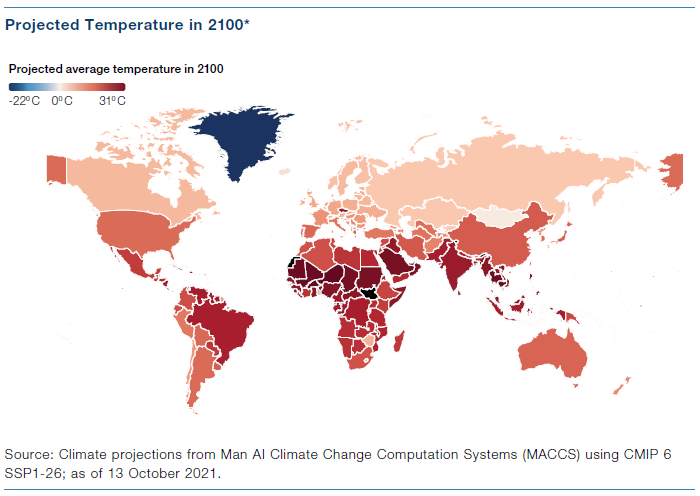
The next map shows the expected economic impact that global heating will have on different countries globally in 2100, again presuming the SSP1-26 is followed. This ranges from a 80%+ drop in GDP/capita in countries including Kuwait, UAE, Saudi Arabia and India to a markedly positive impact for countries including Finland, Russia and Canada. The clear message here is that inequalities between less developed and developed nations will be accentuated by the impact of global heating. We have already witnessed the early signs of civil unrest and even revolution that such inequalities foment – this was the story of the Arab Spring, and arguably the story of ISIS and Boko Haram. There is the potential for more and more extreme incarnations of this kind of violence should such inequalities persist and intensify.
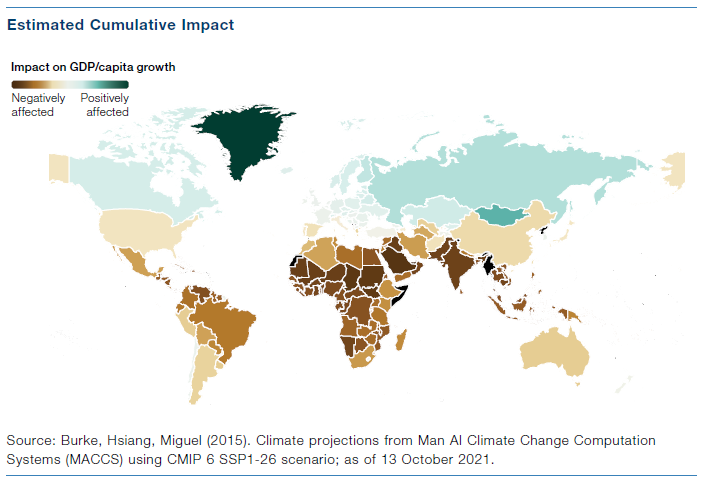
Beyond this relatively high-level analysis, we are able to refine our estimates of revenue losses and costs due to climate change by downscaling climate models – effectively refining them to render them more granular so that we can assess risk on a local scale, even looking at the impact of climate change and consequent natural disasters on an asset-level basis. Using econometrics, we transform the localised, downscaled climate models into assessments of the revenue and cost implications for the companies we are surveying.
1.2 Operational Risk
When it comes to the direct impact on corporations, we can view it as both a demand side problem and a cost problem. The map above shows the extent to which firms will see demand drop in those areas whose GDP shrinks dramatically because of global heating. The map below shows the other side of this coin: the minutes lost per person per day for firms in high-risk industries in 2100. We define high-risk industries as being: fishing, agriculture, forestry, manufacturing, utilities, mining and transportation. While those in northern climes will see little change in the efficacy of their workforces, the impact for companies operating in the Sahel, Bangladesh, Arabia and South America will be far more significant – remember that this includes the effect of increased extreme weather events as well as global heating.

The chart below illustrates how the supply of labour changes under different temperatures. This analysis draws on the work of the American Time Use Survey and the paper ‘Temperature and the Allocation of Time: Implications of Climate Change’ by Graff Zivin and Neidell in the Journal of Labor Economics. It shows that – as indicated in our findings above – there appears to be a series of sweet spots for economic activity in the mid-to-high teens, while productivity declines precipitously once temperature rise above 30-degrees.
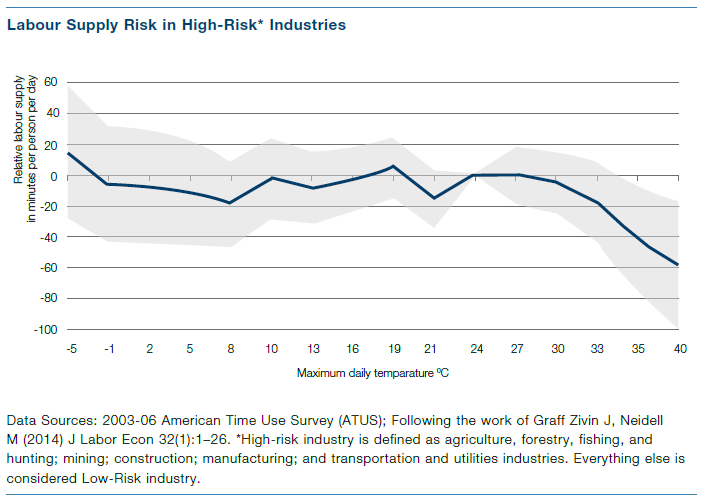
We have so far spoken only about the operational implications of rising temperatures. Of course, there is also the increasing cost of natural disasters, which will strike with greater frequency and cause greater damage. Insurance costs will rise precipitously and there is likely to be widespread migration away from low-lying coastal areas. Different regions have different risks, as the map below illustrates. It is necessary for investors to map these risks onto the companies in their portfolios as well as factoring in greater insurance costs in the future.
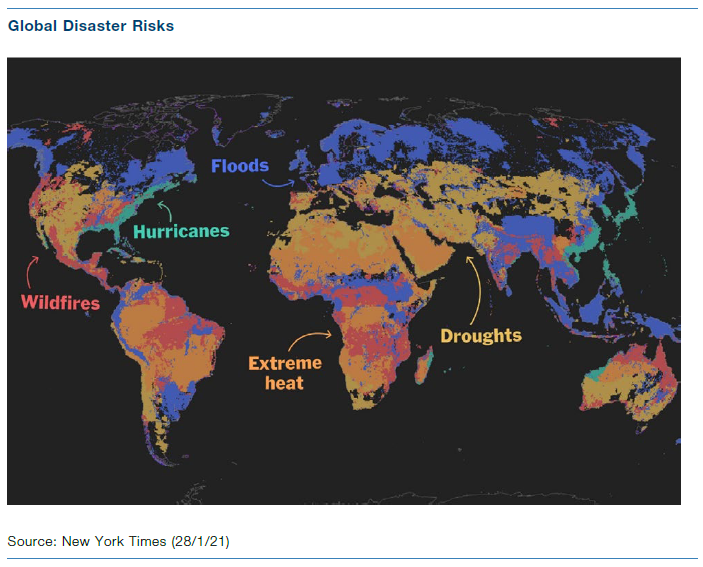
To turn to CoalCo, we use proprietary models to assign a risk score to each of its global locations for each respective disaster risk. In the map below, we show flood risk scores for the company, illustrating how certain areas will see greater costs associated with floods than others. Once we have combined these various risk scores we are able to assign an overall score to CoalCo’s operations and estimate the potential losses from the impact of natural disasters.
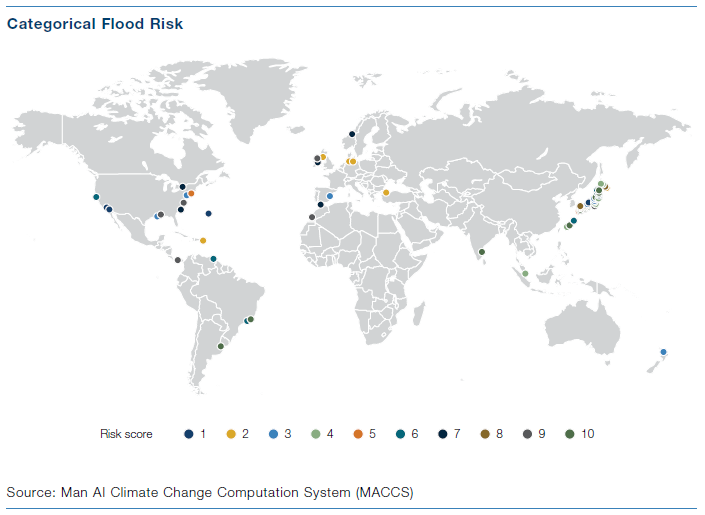
We can drill down further here, looking at companies on a facility-by-facility basis. While this may be viewed as overkill for minor portfolio positions, where investors want to take a meaningful stake in a company, it is important to understand the range of exposures that each firm has to climate risks. Different locations will face different risks and these risks will be mitigated in different ways. It is also possible to map a company’s risk levels to the particular SSP that you expect to transpire, meaning that you can have a range of potential climate-related liabilities depending on the overall level of global heating that takes place. We might focus in on CoalCo’s Indonesian operations(Noting that Indonesia is at such high risk of flooding that it is moving its capital because of flood risk.). These operations are situated in Batam on the Riau Islands, just outside of Singapore.
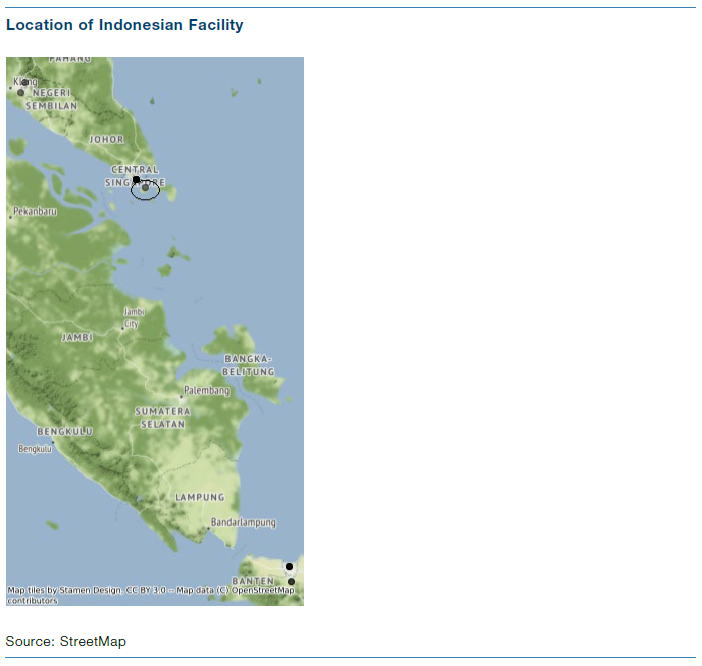
We can model the risk of this specific facility using granular climate models and company data. As the chart below shows, flood risk to this facility is relatively manageable, but there will be significantly greater energy demand as temperatures rise (largely from the cost of cooling the facility and the increased cost of energy) and significantly greater revenue risk given the loss in GDP .
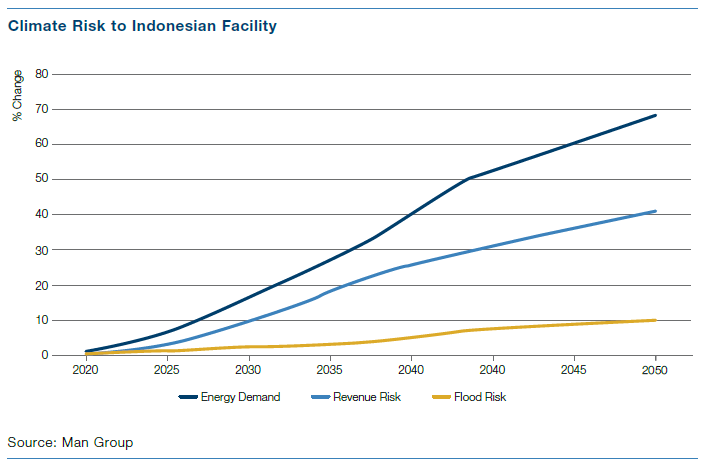
Now we consider the Physical Cost impact of climate change on CoalCo’s balance sheet. CoalCo happens to derive most of its revenue from Russia. As such, the firm will benefit as Russia’s economic activity increases. This translates to an increase in cash and equivalents for the firm. At the same time, many of CoalCo’s mines are in tropical regions where it has faced increased costs from higher energy demands, more frequent extreme weather events and a shortage of labour. This has had a negative impact on cash and has also seen a write-down of the PP&E line item as mines have been damaged by hurricanes.
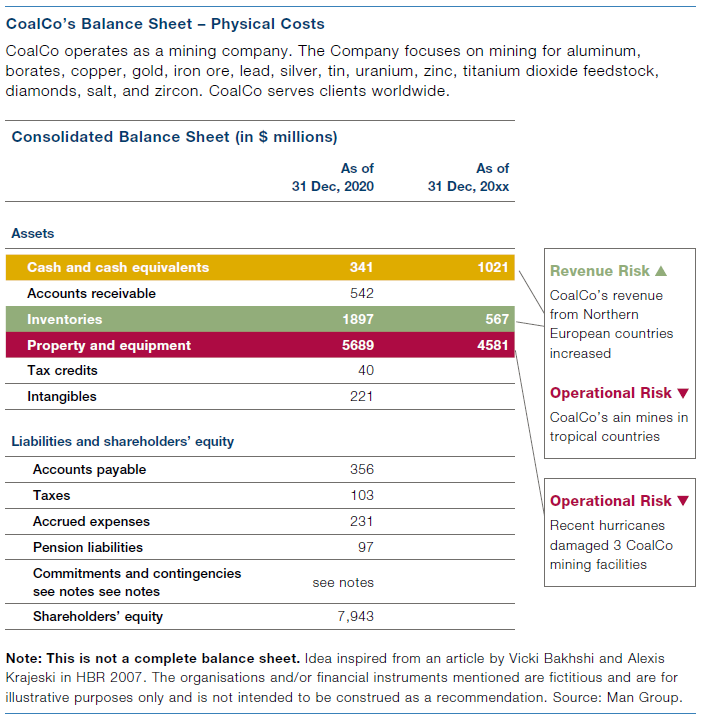
Chapter 2 Transition Costs
Key Points
-
-
-
-
-
The move to net zero will mean that all companiesface some costs, whether to meet regulatory disclosure targets or to finance new technologies.
-
Transition costs will be highest for those in legacy industries.
-
Firms that do not embrace the move to net zero may find the cost of doing business becomes prohibitively high, for instance securing insurance or banking services.
-
-
-
-
The Transition Cost element of our analysis attempts to capture the impact of the move to a low-carbon future, capturing the risk to business from policy and regulatory actions, technological innovation and obsolescence, reputational issues and the change in investor behaviour as capital is allocated away from polluting firms and towards those who successfully rise to the challenge of net zero. The easiest way to estimate a company’s transition risk is via its carbon intensity. This gives an idea of how much the company has to change in order bring itself into compliance with emission reduction goals.
2.1 Charting Corporations on the Path to Net Zero
It goes without saying that companies begin their path towards net zero from different starting places, and that therefore the cost of transition is different based on how far the company needs to travel from its current business model to reach net zero. The chart below shows the two dimensions we use to track where a company is on its journey to net zero.
We have scored the S&P 500 according to two different elements. The first is what their current emissions are. This is obviously largely a facet of which business they are in. We then look at how closely-aligned they are to the emissions reductions required by the Paris Agreement. To do this we use data provided by the Science Based Targets Initiative. This is a partnership organization between the CDP (Carbon Disclosure Project), the United Nations Global Compact, the WWF and others, that has come up with a framework to determine the extent to which each industry must reduce their emissions if we are to achieve the Paris Agreement. The SBTI data looks at both the realistic measures firms in an industry might take to reduce their emissions and what lower-carbon alternatives there might be to their business models, before allocating each firm a series of emissions targets.
The top left point of the graph below represents a ‘Large Construction Material Producer’ which necessarily emits lot of carbon and hence scores very highly on the carbon emissions dimension. But we don’t have any alternative for cement yet, hence, in order to support the economy we have to allow cement companies to keep emitting. Therefore, notwithstanding the higher emissions, from an alignment angle this company scores amongst the highest in the S&P500 (note a lower score here represents better alignment).
On the other hand, let’s look at the example of a ‘Leading Entertainment Company’ on the bottom right. The company emits very low carbon but still doesn’t score well on the alignment angle because compared to its industry trend and based on what it could realistically achieve it is still emitting more than it ought to be emitting.
So transition costs are a function of both the current level of emissions and the potential for alternatives/reduction in carbon usage of each company’s current business model.
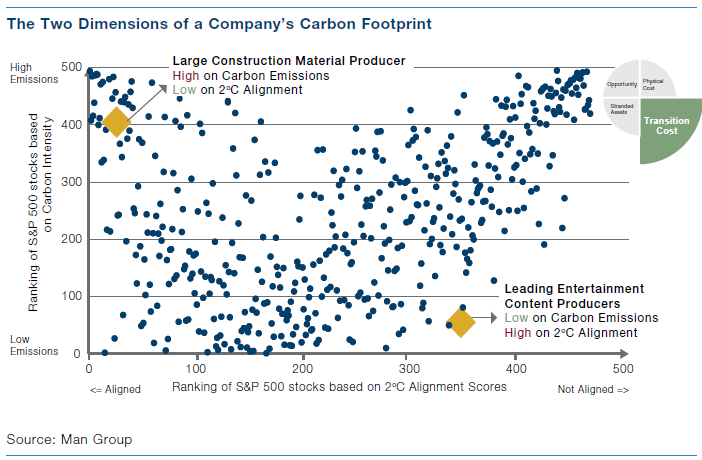
Transition costs can manifest themselves in a variety of different ways. It is, for instance, more difficult for heavily-emitting firms to secure insurance, given the greater risk profiles of their businesses. Seventeen major firms including Chubb, Generali, Swiss Re, Axis Capital, QBE, and Allianz have announced that they will limit insurance provided to energy firms because of climate concerns. AXA has announced that it will cease providing coverage to any new oil pipelines, coal plants, and tar sands projects. As the company’s CEO, Thomas Buberl, put it: ‘A +4°C world is not insurable.’
It’s also harder for such firms to get even basic banking services. HSBC, for instance, recently announced that it will no longer finance the construction of offshore petroleum projects in the Arctic, tar sands developments in Canada, or most coal-fired power plants. Other large banking institutions such as ING, BNP Paribas, Wells Fargo, Morgan Stanley, Legal & General, JPMorgan, Deutsche Bank, and the World Bank have announced similar policies regarding their relationships with fossil fuel companies.
It’s important to draw a distinction between 1.5-degree alignment and carbon intensity as measures of a company’s vulnerability to transition risk. Different firms will be in different positions as far as a number of elements extraneous to the mandates of the Paris Agreement. These include the stringency of local regulations and government interpretations of pledges – note that the Netherlands pursued Shell even though other energy firms are far less aligned; on the other hand, Australia has been consistently unwilling to penalise coal producers. There are also second-order impacts like investor sentiment and pressure from employees, suppliers, customers and other stakeholders. In order to achieve a rounded picture of transition risks, it’s important to consider not only where a firm lies in relation to its declared goals, but also to the second order pressures that it faces from its wider ecosystem.
One final point worth noting here: it may seem at first glance that we will therefore be predisposed to invest in companies who are less likely to face pressures from government, investors and their wider stakeholders. This is obviously a perverse situation and we remedy it by increasing the physical costs associated with these companies. This recognises the fact that transition risk and physical cost are to some extent mutually exclusive; that is, if a government cracks down on a company’s emissions it will face near-term costs to meet regulations but potentially be less impacted by overall climate change; conversely, firms who aren’t penalised may benefit in the near term but suffer more serious long-term consequences.
Let’s turn now to our fictional CoalCo, for whom transition costs will necessarily be high given its business model. We can see here the impact of policy and regulation on the company. The firm was fined for failing to meet emissions targets, reducing its cash and equivalents. It also had carbon tax liabilities, although these were somewhat offset by tax credits earned by its newly-launched subsidiary, WindCo.
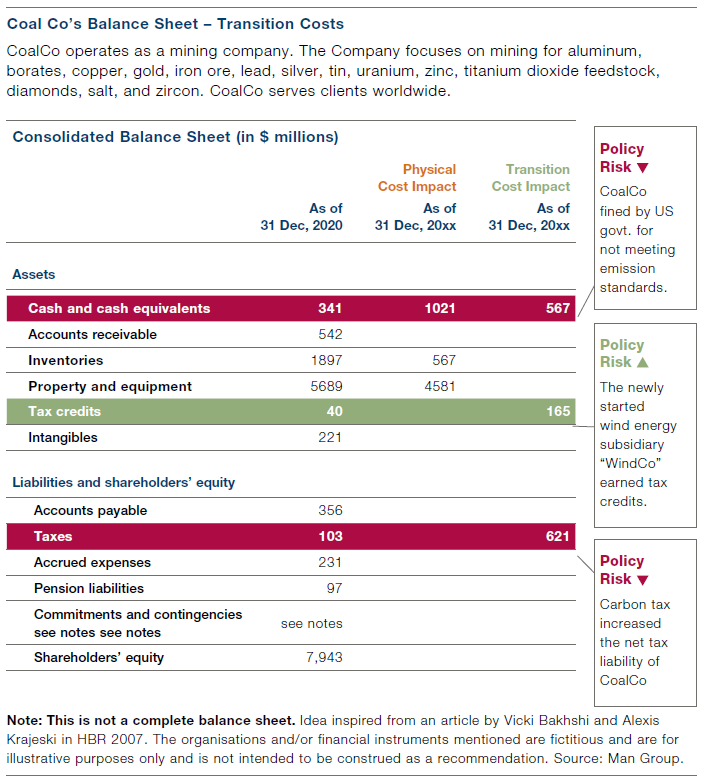
Chapter 3 Stranded Asset Costs
Key Points
-
-
-
-
-
Stranded assets are most visible in the energy sector, where many reserves may never be tapped.
-
Companies will need to think realistically about the valuation of their assets in the light of climate change.
-
-
-
-
Reserves are a core element of energy company valuations, as shown by the chart below. This is notwithstanding the fact that the International Energy Agency has estimated that 60% of oil and gas reserves and over 80% of coal reserves should remain unused in order to meet Paris Agreement targets. It’s clear that there is something here that is not adding up, and either investors are betting that the move to net zero will be slower and less successful than current policy targets suggest, or they are over-valuing energy companies, which recently had to write down of $20bn of reserves globally.
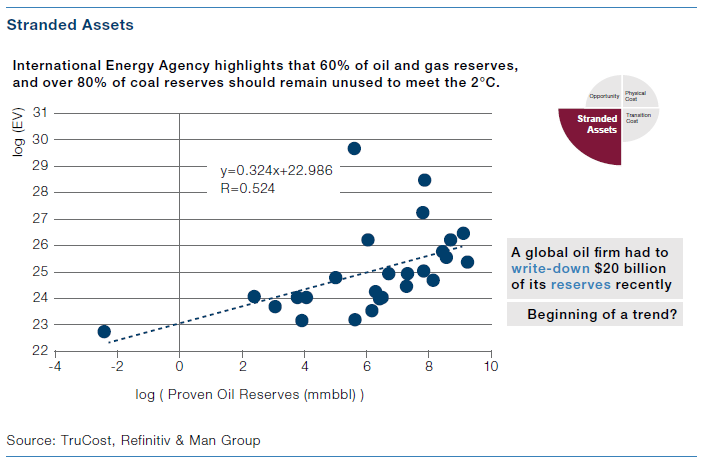
If hydrocarbon asset stranding does take place, it will either be driven by regulatory fiat – governments imposing limits on production and consumption of hydrocarbons – or technological change – leaps forward in renewable energy rendering oil, gas and coal uneconomical. As the chart below illustrates, energy firms in the West have a higher cost of extraction than their OPEC/Russian state-owned peers. This dynamic is key when it comes to understanding how energy firms fare in the move to a low/zero-carbon future. If fossil fuel reserves are stranded due to regulation, it is possible that the Western companies with their higher production cost locations may suffer the most pain. In contrast, if hydrocarbon asset stranding takes place due to technological change and cost reductions in the price of renewable power systems, then volume-oriented US companies may have time to deplete most of their reserves while national oil companies in such places as Saudi Arabia and Iran will wish they had pumped more and faster.
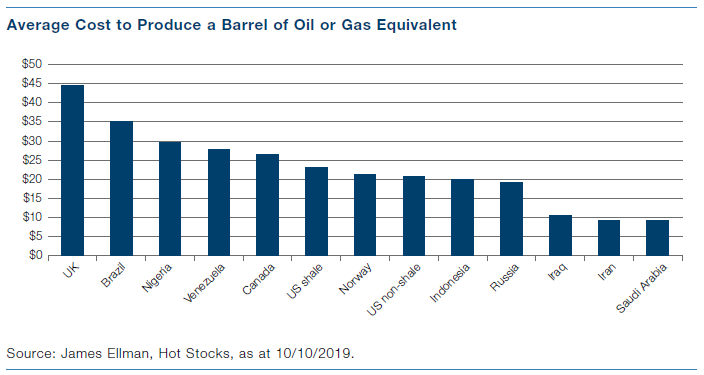
The likeliest outcome is a combination of the two elements, with regulation driving technological innovation in renewables, a scenario that would see both Western energy companies and their state-owned peers suffering equally.
We have spoken so far about the energy sector as this is where the stranded asset issue is both most obvious and most potentially costly. But there will be stranded assets in almost all industries as the world moves towards a zero-carbon future. For instance, the chart below illustrates the years until various states will ban the sale of new cars with internal combustion engines. The transition to electric vehicles will necessarily leave stranded assets in its wake, both in terms of the cars themselves and the facilities used to manufacture them.
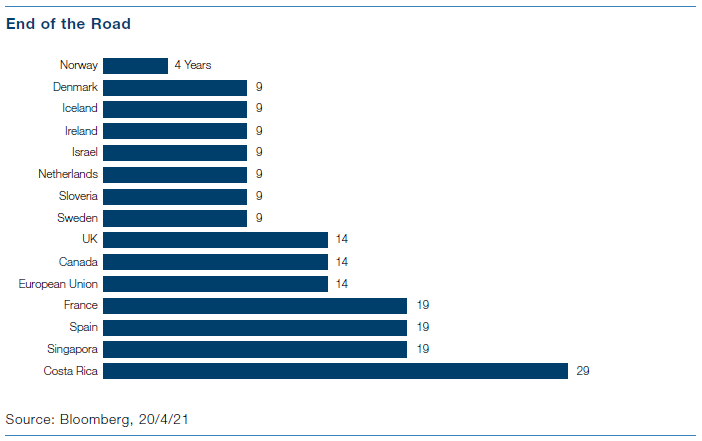
Let’s now return to CoalCo and see how stranded assets impact our fictional balance sheet. The answer is not good. In our putative example, the US government increased carbon taxes and imposed a new ‘fossil fuel reserve’ tax, which rendered five of the company’s mines uneconomical. These mines were then closed and written down to zero, a move reflected in the PP&E line in the company’s balance sheet.
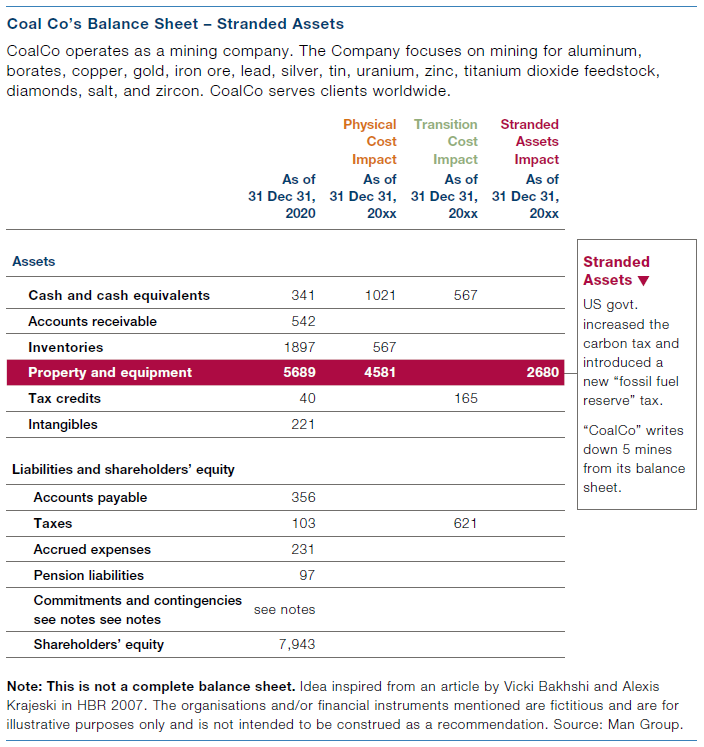
Chapter 4 Opportunity
Key Points
-
-
-
-
-
The move to net zero presents companies with opportunities as well as risks.
-
Forward-thinking management teams will position their business to benefit from the changing corporate landscape.
-
-
-
-
Of course, as a careful read of earlier sections of this paper makes clear, the move to net zero presents management teams with as many opportunities as it does challenges. We will therefore finish this section with a consideration of the possible benefits that will accrue not only to those green economy firms able to seize this historical moment, but also to those traditional firms whose management teams are forward-thinking enough to position their companies for the zero carbon economy.
It’s clear that there will be numerous firms operating in renewable technology, electric transportation and carbon capture who stand to benefit from the move to a zero-carbon economy. And yet we are currently in a situation of extraordinary frothiness in all green sectors as companies battle to establish themselves and investors seem willing to support even the most half-baked green strategies. We spoke above about the necessity of clear-eyed consideration of the risks and opportunities associated with investing in green technology. We would also urge investors to recognise that not all firms operating in apparently non-green industries ought to be excluded from portfolios as a matter of course. Some energy companies have aggressively embraced the transition to renewables, while there are other companies who responded positively to investor criticism of sustainability practices and have substantially improved their climate performance as a result.
To give examples of firms that have responded positively to some of the challenges of climate change, we might firstly cite Ikea, the world’s largest furniture retailer. Ikea had been criticised for the short (shelf) life of many of its products and the firm’s place in an economic system which prioritised novelty and waste over durability and restoration. In response, the company took a variety of steps to radically alter its business profile. It has meaningfully reduced its virgin wood consumption by switching to recyclable loading pallets, is moving to sell only energy-efficient LED lightbulbs, and has invested in a renewable power production to meet its total energy consumption. Ikea now owns more than three hundred wind turbines and has installed seven hundred thousand solar panels on its buildings.
Kimberly-Clark is one of the world’s largest personal care companies with brand leadership in many product areas including Cottonelle toilet paper, Kleenex facial tissue, Kotex tampons, and Huggies disposable diapers. It has received significant negative publicity in the face of its impact on the environment, with several NGOs calling it out for poor sustainability. In the face of this pressure, Kimberly-Clarke embarked on a number of environmental initiatives in recent years. These included reducing its water use by more than two million cubic meters, diverting 95 percent of its manufacturing waste from landfills by utilizing recycling technologies, reducing its GHG emissions by 18 percent, and sourcing all of its virgin wood fibre from certified sustainable forest providers.
Looking longer term at the opportunities presented by the impact of climate change, we might focus in on construction companies who will benefit from the radical reshaping of the built environment as populations move away from the sea and towards higher ground. There is also the necessity to rebuild in the wake of storm and wildfire damage. Similarly, we might see an increase in infectious diseases as a result of increased flooding and storms, meaning that healthcare companies stand to benefit. Both of these eventualities remain too far out to influence current portfolio construction, but we would urge investors to begin thinking along these (admittedly sobering, not to say depressing) lines sooner rather than later.
Finally, let us turn to CoalCo, a company whose future might have seemed bleak with the coming of the green revolution. In fact, the investment the company’s investment in research and development related to renewable technologies and minimising the carbon emissions of its activities meant that it saw an increase in cash and equivalents and intangibles on its balance sheet.
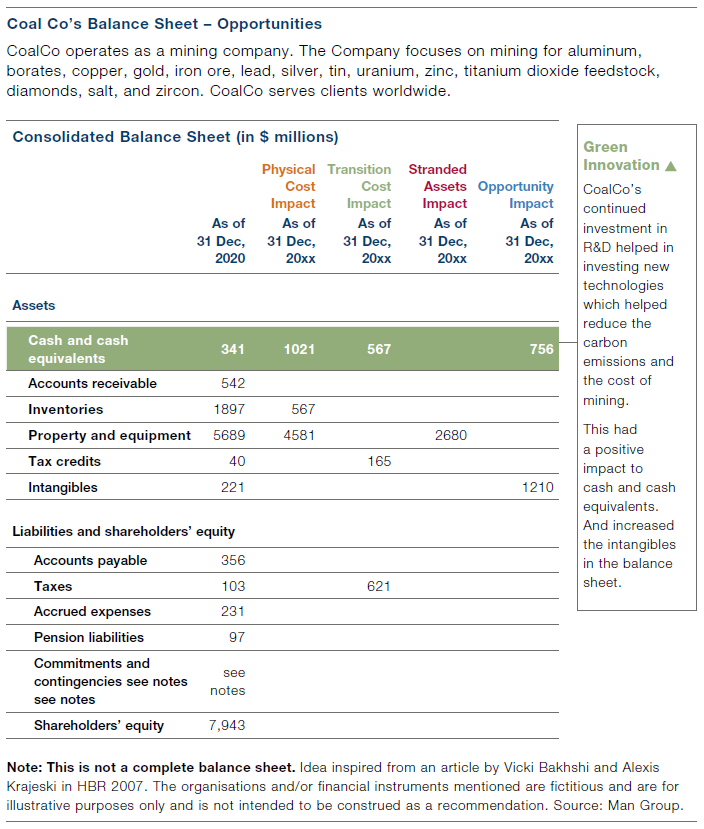
Chapter 5 Portfolio Management in a Warming World
Key Points
-
-
-
-
-
Investors should think of both opportunities and risks in the move to net zero.
-
Climate is now part of a suite of metrics applied to company valuation.
-
This is not only about equities: all asset classes will be impacted by climate change.
-
-
-
-
The next Part of the White Paper charts the rise of sustainable and ESG investment and the emerging Climate+ investment class. Many of these strategies seek to harness the opportunities inherent within the transition to net zero, but investors also need to recognise the full spectrum of risks that come from climate change and take steps to hedge these risks as best as possible. The key question we have sought to answer in the preceding chapters is whether, and to what extent, climate change will impact the earnings of the firms in which we invest, whether this be in a positive manner – opportunities in green technology, the economic viability of previously frozen areas, new and more efficient shipping lanes – or, and this will be the majority of cases, negatively – whether through falling GDP in many areas, the rendering of large areas uninhabitable due to extreme temperatures and consequent labour issues, or the cost of natural disasters and higher insurance fees.
We view the climate change framework presented above as a kind of a puzzle – each model in it is trying to capture one aspect of the various ways in which a firm’s earnings will be impacted by a warming world. The graphic below shows how we combine these various elements, alongside more traditional factors and ESGrelated metrics to come up with a climate positive valuation of a firm.
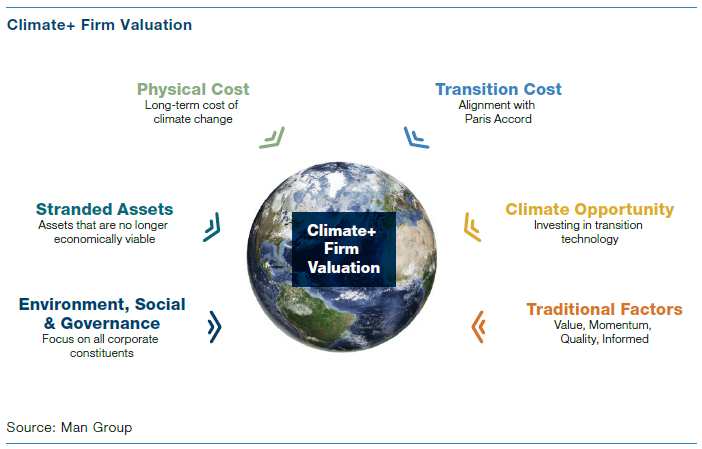
One thing is clear when we move from traditional valuation models, through the newer ESG models, to climate models that have very little historical data to validate them: we are in new territory here and quantitative models rely on backtesting to generate consistent outputs. This means that we have to be very careful when calibrating and verifying climate models, making sure that those we use are based on strong fundamental hypotheses.
A warming world is a reality that must be accepted and negotiated by companies and their customers alike. Even in the best-case scenario of temperature rises being maintained at less than 1.5 degrees below pre-industrial levels, there will still be global heating that is unevenly distributed across the world. We are currently at 1.2 degrees of warming and are already seeing significant impacts from climate change in more frequent and deadly natural disasters. We must also remember that there is a lag between climate change and its impact, meaning that certain consequences will only be visible in the decades to come. Even with 1.5 degrees of warming, we will see some areas become almost uninhabitable, while others will see benefits accruing from the rise in temperatures. The whole structure of the global economic landscape will change, with demand falling in aggregate and precipitously in certain regions. Certain companies will thrive while others will find demand falls dramatically and assets they had valued on their balance sheets according to the rules of the old world order are suddenly worth far less than they expected, or even that they have become worthless. Innovation presents both opportunities and costs, with the likelihood that energy and mining firms in particular will face much higher risks and greater volatility of earnings as we move towards the century’s mid-point.
Asset owners need to think about how this radically altered landscape impacts the companies and securities in their portfolios. While we have largely focused on equity investors in this part of the paper, it’s clear that global heating will have implications across companies’ capital structures and across multiple asset classes. One only needs to look at the divide that has opened up in prices in Miami between properties at sea level and those above sea level. This kind of discrepancy will be played out in the coming years across all asset classes as it is increasingly recognised that a warmer world will ask questions of investors that they simply have not had to think about before. We hope that the ideas in this section of the paper are a useful starting place for those considering this vast and complex transition.
Part 3
Sustainable Investing and ESG
ESG has become the dominant movement in contemporary asset management.Climate is only one element of the E in ESG.
Is ESG a factor?
What securities are best from an environmental perspective?
Introduction
A paper several times the length of the one you’re reading could be devoted to the rise of Environmental, Social and Governance (ESG) investing. Clearly, we will concentrate here on the environmental element of the triumvirate, although it ought to be obvious by now that separating the environment and climate from other aspects of ethical investment (and, indeed, broader social behaviour) is not entirely simple. Just as the Paris Agreement takes into its ambit the inequalities that persist between developed and less developed nations, there are many overlaps between investment strategies that are good for the climate and those that benefit workers. Similarly, it is impossible to write about sustainable investment without also considering the governance implications of climate change: from good stewardship to board appointments, climate considerations will permeate every aspect of the investment ecosystem in the years to come.
It should be pointed out, however, that climate is, at least in theory, only one element of the E in ESG. It’s possible to imagine that a company has a very low E rating because of a poor environmental record when it comes to leaching hazardous materials into water sources or managing its waste products while actually achieving carbon neutrality from a climate standpoint. Such is the urgency of the climate crisis, however, that we believe E(nvironment) and climate have become more or less interchangeable in investors’ minds. A survey carried out by Verdict in April 2021(7) found that climate was by some distance cited as the most pressing ESG concern by investors, with nearly 70% listing it in first position. We also believe that, while the example we gave earlier of a company performing well on climate but poorly on other aspects of ESG is possible, it is hardly likely. Indeed, we’d make the opposite conjecture: it seems clear to us that firms that perform well on climate tend to perform well not only on other environmental factors, but also on all other elements of ESG. A firm that is concerned about climate is thinking about the future and shaping its business for the long term. This requires good social and governance policies as well as a sound environmental position.
In the following chapters, we outline the key considerations for investors in this space, from ratings providers to regulation to greenwashing. We then cover stewardship and activism, before finishing with a chapter proposing a framework for thinking about investments that will benefit from a move to a green economy.
Chapter 1 The Rise of Sustainable Investing
Key Points
-
-
-
-
-
ESG is merely the latest iteration in the history of sustainable/responsible investment.
-
How has it succeeded where so many failed?
-
Does ESG actually work?
-
-
-
-
Ethical investment is nothing new, indeed it is almost as old as the financial services industry itself: many of the early banks were Quaker institutions with a clear ethical mandate to their investing activities. What has changed in recent years is a growing recognition of the central role that finance will play in the transition to a green economy (and the shadow recognition of the role the industry has played in polluting the atmosphere in the past). It feels like the past five years have seen a step-change in the way that both investors and the financial services industry more broadly think about sustainability. AIMA (the Alternative Investment Management Association) carried out a survey of its members each year. As recently as 2017, it was possible for almost 60% of those surveyed to state that they had no plans to integrate sustainability into their investment practice. That number has more than halved in the most recent survey, as it is increasingly recognised that ESG risks must be factored alongside the more traditional elements of risk management and, crucially, that investors will no longer commit capital to those who ignore the most significant crisis our species has faced. Inflows into ESG-focused funds have been resoundingly positive and look set to continue.
The Many Faces of Responsible Investment
Socially Responsible Investing (SRI): An early incarnation of ethical investment. Sometimes just called Responsible Investment.
Impact Investing: Seeks to invest in companies or assets with a clear positive social or environmental impact.
ESG Investing: Investing with a focus on environmental, social and governance performance, as well as financial performance..
Sustainable Investing: A broad term incorporating everything from exclusionary screening to active impact investing.
Triple Bottom Line: An accounting framework that combines financial, social and environmental aspects. An attempt to address ‘total cost accounting.’
Corporate Social Responsibility (CSR): Corporate responses to demands for ethical behaviour.
Sustainable investment has gone through a series of different iterations in recent decades. The sidebar to the right gives just a selection of the various guises it has taken on. It does feel, though, that the popularisation of the term ESG Investment coincided with sustainable investment’s move from the outer edges of the investment industry to the mainstream. Even within ESG, there have been a number of different approaches to best practice. ESG was initially dominated by exclusion lists and the divestment movement. As the chart below illustrates, in 2016, exclusionary screening was by some distance the dominant form of ESG investment. We will outline objections to exclusion lists in the chapter on stewardship, but it is clear that integration – where ESG risks are incorporated into funds’ broader mandates – is now the clear leader as far as ESG strategies go.
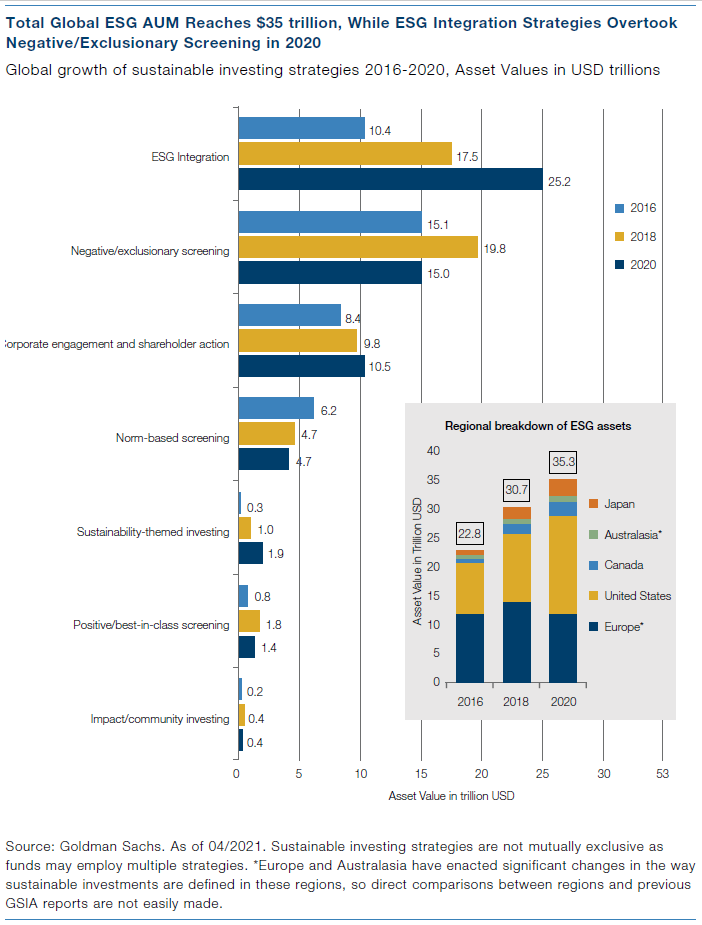
It’s worth briefly looking at why ESG has taken hold where previous approaches to sustainable investment have not. Partly, of course, this is a reflection of the increasing urgency of the climate crisis and the shortening time horizons by which humanity can take steps to control global heating. There is, though, something more specific to the investment industry currently taking place. Investors in Europe have always blazed a trail when it comes to responsible investment, particularly large institutions – pension funds, insurance companies and sovereign wealth funds. What we have seen in that the proactive, engaged approach taken by these institutions has been gradually adopted by other similar institutions globally. So, for instance, in the US a number of major pension funds have announced significant increases to their investment in ESG-related strategies (and this notwithstanding the court ruling in October 2020 that hampered such funds from making investments with non-financial mandates. Similarly, Australian and New Zealand super funds are taking a leadership role in establishing ESG at the core of their investment strategies. While some have spoken of an ESG bubble (and we will go on to some of the challenges faced by the ESG movement), it’s now clear that if you want to raise capital from some of the world’s largest investors, you need to have a clear ESG vision.
Also contributing to the growth of ESG is the explosion in data availability. Systematic trading of equities (and increasingly other asset classes) and the growth of big data has meant that firms are able to call upon a vast amount of information to support their ESG investments. With the growth of third-party data vendors and ESG ratings companies, it is no longer possible to claim that there is insufficient information available on which to base ESG decisions. There is, though, still some way to go in the standardisation and quality assurance of ESG data, a subject we’ll return to in the chapter on ratings vendors.
As with the adoption of systematic trading strategies, ESG investment began with equities and has slowly fed through to other asset classes. While credit investors usually do not have the same ability to impact the behaviour of the companies they invest in, there is an increasing recognition of the need to exert pressure on management from across the capital structure to act in a sustainable fashion. Impact investment in housing is a fast-growing space where environmental considerations are a key driver of outcomes. Commodities is an area that clearly presents significant challenges to investors seeking sustainable returns, but, as we will see later in this paper, these challenges can also be seen as opportunities. ESG now touches every sphere of the investment universe, from sovereign debt(8) to cryptocurrencies (Bitcoin currently uses around the same amount of energy annually as Sweden(9)).
It is worth posing an obvious question here: does ESG investment actually work? A recent paper by researchers at New York University noted that over 200 academic papers published between 2015-2020 claimed that ESG funds outperformed the market, with an average outperformance of around 1% per annum and clear correlation between performance in ESG and financial performance. But more recently there has been a growing wave of scepticism regarding these claims. Research by Clark, Feiner, and Viehs (2015), Friede, Busch, and Bassen (2015), and Khan, Serafeim, and Yoon (2016) finds that ESG is additive to returns, while research by Brammer, Brooks, and Pavelin (2006), Fabozzi, Ma, and Oliphant (2008), and Hong and Kacperczyk (2009) demonstrates that ESG detracts from returns. A recent study by researchers at the University of Milan noted that, although ESG-focused strategies had outperformed in the past decade, the differential between ESG leaders and laggards was narrowing swiftly, as the chart below illustrates.
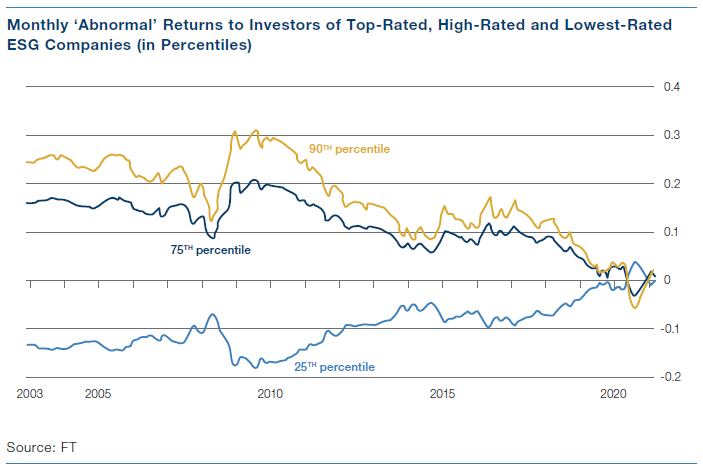
Part of the problem here is that we are still early in the life of ESG investing and there is much that is still to be established in terms of what precisely we mean by ESG investing and how we establish which firms have outperformed according to which metrics. We look later in this paper at the complexities and nuances of sustainable investing, but, in short, we need to recognise that there are probably not yet enough data to make a definitive judgement. Our best guess is that initially strong flows into ESG outperformers (and the withdrawal of capital from those who underperform) will mean that ESG continues to see positive momentum in the short-to-medium term. Eventually, though, given the lower risk associated with ESG outperformers, these securities should naturally offer lower returns than their riskier peers. Good ESG credentials essentially act as a convenience yield and so a lower expected return is required by the market.
Chapter 2 ESG Ratings Firms and Frameworks
Key Points
-
-
-
-
-
The heterogeneous nature of ESG ratings is the main issue facing the further development of investing in the space.
-
The ‘Alphabet Soup’ of ESG ratings needs to be clarified into a more comprehensible and visible categorization system similar to credit ratings.
-
-
-
-
ESG analytics started being provided in the 1980’s by firms such as Vigeo-Eiris (now owned by Moody’s) and Kinder, Lydenberg, Domini (KLD, now owned by MSCI). This data provided a way to rate companies based not only on their financial performance but also on their impact on the environment and society more broadly. The information was initially consumed largely by faith-based investment managers who wished to incorporate an ethical element into their investment practices.
The growth of the ESG movement has driven the establishment of a number of ESG rating agencies and international frameworks seeking to provide investors with the tools they need to make informed investment decisions. These ratings are already both incredibly important in the development of a coherent and consistent ESG investment ecosystem and the source of deep frustrations from investors.
ESG data providers cover a wide range of indicators, measuring the characteristics of a firm according to different metrics such as diversity, corporate governance, emissions, labour practices, etc. The exhibit below from Berg et al. (2020) provides a list of categories (rows) for which different providers (columns) publish indicators. Each cell reports the number of indicators that a certain rating company provides for a certain category.
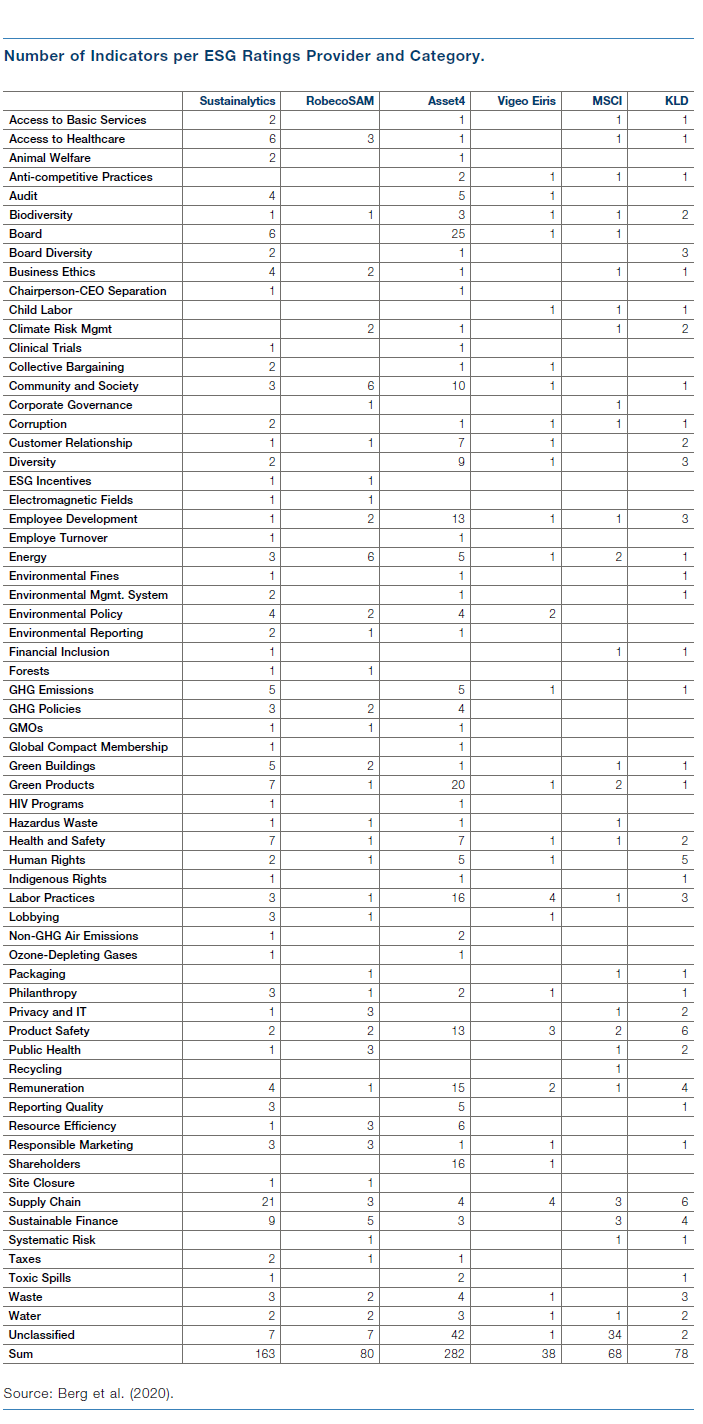
The large variety of data unfortunately has not come with standardization. Chatterji et al. (2016) document a substantial lack of agreement between ESG ratings from different providers. Such disagreement persists even after adjusting for differences in methodology. Berg et al. (2020) find that a main source of divergence between providers is caused by the fact that different firms may measure the same attribute with different variables (e.g., measuring labour practices with workforce turnover vs. number of labour-related lawsuits). Another measurement issue is that there seems to exist a rater effect, whereby raters that score a company high in a certain category will tend to give it a high score also in other categories.
As a concrete example of how three major ESG data providers can vary in their view is provided in the exhibit below.(10) The different environmental scores for Tesla are particularly remarkable: it gets a near-perfect score from MSCI because of the low amount of carbon produced by its products (electric cars), while Tesla gets a zero from FTSE because it focusses on the emissions from its factories.
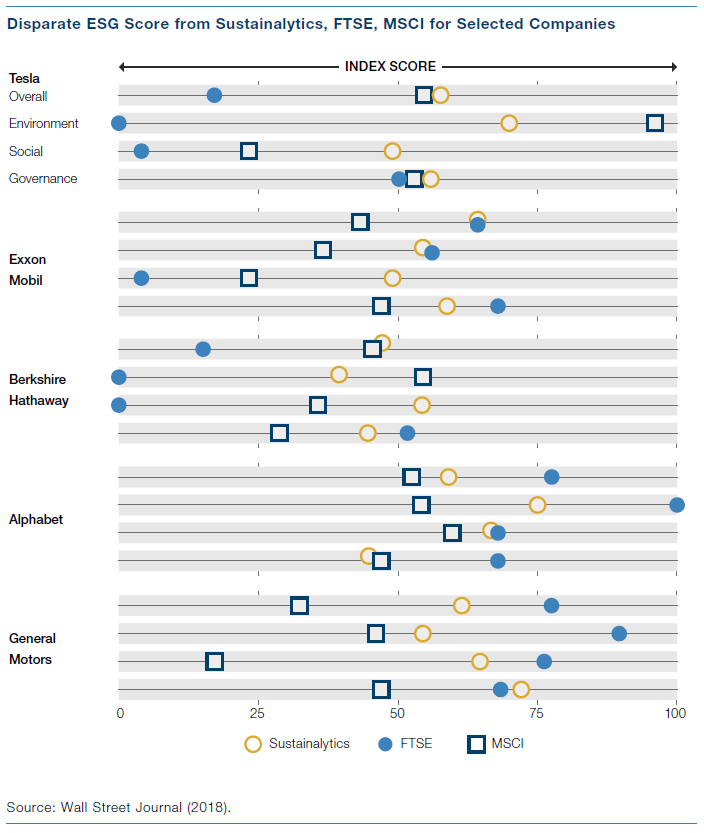
A 2018 paper by Robert Eccles and Judith Stroehle at the University of Oxford entitled ‘Exploring Social Origins in the Construction of Environmental, Social and Governance Measures’ outlined the issue surrounding ESG data provision succinctly. ‘As there is no generally agreed-upon set of measures to capture the fuzzy concepts which describe a firm’s non-financial performance, the construction of ESG is virtually left to the discretion of the undertaker,’ the authors wrote.
Sustainalytics, which is owned by Morningstar, uses proprietary software to gather and analyse data and has a team of more than 350 analysts looking to assess the ESG risks that companies face. It rates companies both within the total corporate universe and within their industry groups. The ratings range from ‘negligible’ to ‘severe’ risks. For example, Sustainalytics rates ExxonMobil a high risk primarily due to its carbon-heavy operations. As for companies that fall under the S-forsocial segment of ESG, Sustainalytics scores Facebook a medium risk because its vast collection of user data raises privacy, security, antitrust, and reputational exposure.
In contrast, MSCI, another major ESG ratings firm, focuses on comparing companies’ ESG performance relative to their sectors. It uses a letter-based system similar to those employed by credit rating agencies, ranging from AAA to CCC. MSCI rates ExxonMobil an average BBB, which is better than Sustainalytics’ grade. Yet MSCI branded Facebook a laggard with a B because it compares so unfavourably with the two dozen or so peers in its industry. That’s worse than Sustainalytics’ rating.
Add to this the ratings provided by other data vendors – Thomson-Reuters, Standard & Poor’s, Refinitiv and others, and you end up with what many have called an ‘alphabet soup’ of different ratings, where comparability is difficult and resulting in the aforementioned issues regarding size and geographical bias. All of this makes for significant difficulties when it comes to establishing what actually constitutes a sustainable investment. The (busy) graphic below gives an idea of just how confusingly crowded this space currently is.
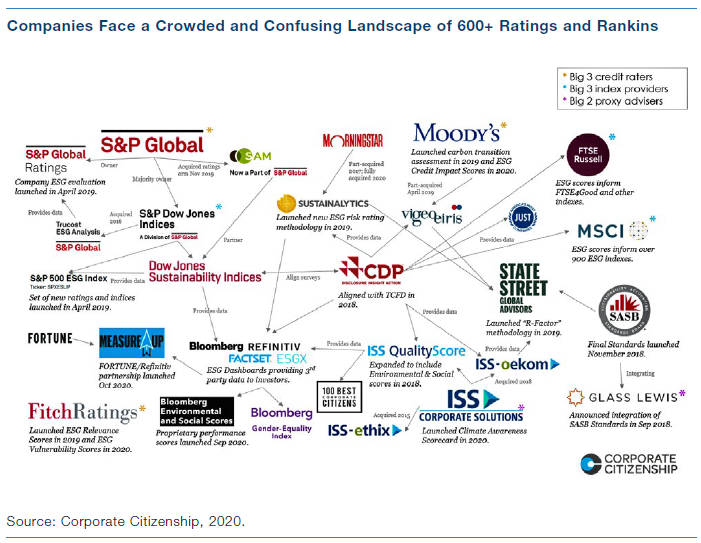
There are a number of public organisations seeking to provide frameworks in these areas. The Sustainability Accounting Standards Board (SASB) evaluates the financial materiality of ESG factors and provides guidelines industry by industry. It lists 77 industry metrics that track the impact of environmental issues on company accounts. The Task Force on Climate-related Financial Disclosures aimed at assessing a company’s exposure to climate change risk. The TCFD was set up in New York five years ago by the G20’s Financial Stability Board under its former chair, Mark Carney, then Bank of England governor.
What we need is a generally acceptable and consistent disclosure and ratings process similar to international accounting standards. It may be that this wish is close to being granted. In November, at the UN’s COP26 climate summit, the International Financial Reporting Standards Foundation — which develops and promotes international accounting standards — is set to launch a global Sustainability Standards Board. If governments adopt the standard, as experts believe many will, ESG measurement and reporting could become more streamlined and easier to execute. Certainly, this remains an area where there needs to be concerted action in order to drive a more coherent and comprehensible ratings landscape.
Chapter 3 From ESG to Climate +
Key Points
-
-
-
-
-
As climate investment matures, investors will increasingly seek to differentiate their climate positive portfolios from more generic ESGrelated strategies.
-
Different data vendors have different approaches to climate data.
-
Investors should seek to combine information from different data sources to form robust climate-focused stock selection procedures. The most sophisticated investors will develop proprietary models that incorporate raw data as well as third-party ratings.
-
-
-
-
We stated above that climate is just one of a range of different factors considered within the ‘E’ of ESG. Increasingly, the data vendors who provide ESG ratings are also providing discrete climate- related ratings to enable investors to make informed decisions specifically about climate. We recognise that so far in this paper we have largely gone along with the equivalency many have drawn between ESG and climate. This is because we believe that the former works well as a proxy for the latter. But it is not a perfect fit and as the market for climate positive investment develops and the quality and granularity of the data improve, we expect investors to focus increasingly on specific climate ratings.
Climate ratings are only marginally less bewildering than their ESG counterparts. Firstly, there are the climate elements of ESG data vendor ratings. So Sustainalytics provides a series of ratings under its Climate Solutions umbrella. These climate ratings also filter into its ratings for a firm’s environmental performance, proving clearly the overlap between the two spheres. Sustainalytics further breaks down its climate ratings into six distinct areas: Carbon Risk Ratings, Carbon Solutions Involvement, Carbon Emissions Data, Fossil Fuel Involvement, Stranded Carbon Assets and Engagement. These sub-divisions provide a neat shorthand for highlighting the ways in which ratings firms think about the different risks and opportunities provided by the move to a zero-carbon future.
Similar ratings are provided by MSCI, who supply over 700 unique climate-related data points about the firms they survey. These metrics are structured around the firm’s analytical framework for net-zero, which seeks to chart the various stages in a company’s journey towards carbon neutrality. The four key pillars of this framework are transition risk, green opportunities, 1.5-degree compliance and physical risk.
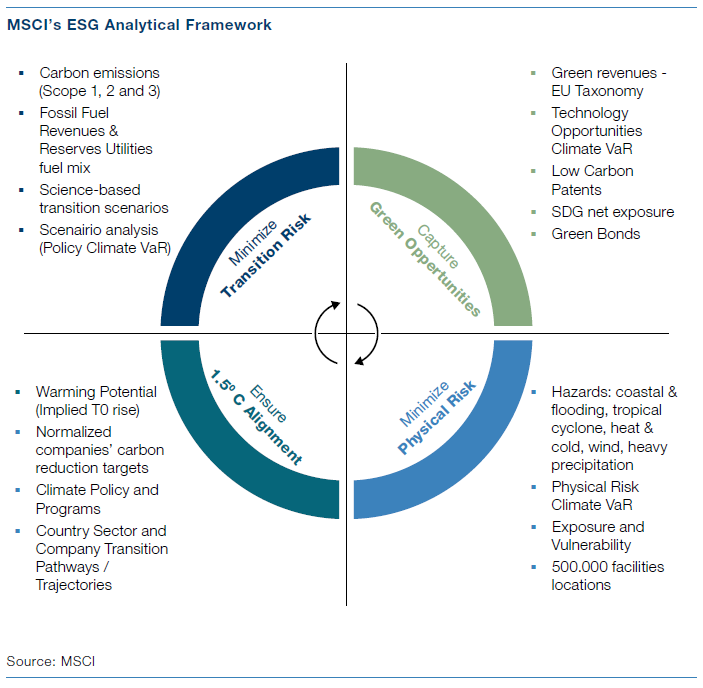
It is particularly worth focusing in on MSCI’s Climate VaR metric, which seeks to establish a forward-looking and returns-based data point for investors, establishing the degree to which a company (or, indeed, an entire portfolio) is exposed to climate-related risk. This is interesting as, unlike metrics like carbon footprints, it does not rely on historical data but rather seeks to map the future path of a company’s climate risks.
Alongside ESG data vendors there are a number of specific climate ratings providers whose work is focused solely on climate risk. The most established of these is the CDP (formerly the Carbon Disclosure Project), which issues firms with a letter-rating – CDP Scores – based on their emissions performance. CDP lists the companies that make its A list each year – in 2020 there were 277 companies globally that were given this highest rating.
Increasingly, investors are developing their own proprietary models to measure climate risk and prepare their portfolios for the transition to net zero. We have found that third-party vendors tend to cover carbon and efficiency-related metrics well, while assessments of physical risks tend to be more provisional and backwardlooking. When it comes to climate models, the past is not a good guide to the future and climate models are just not linear projections. We suggest investors wishing to capture the physical risks associated with their portfolios incorporate econometric models that allow them to assess the potential damage from the variety of physical risks posed by climate change.
Chapter 4 Environmental Regulation in the Investment Industry
Key Points
-
-
-
-
-
There are a number of global organisations seeking to drive ethical and sustainable investment in the financial services industry.
-
Europe is leading regulation of financial services, with Sustainable Finance Disclosure Regulation scoring funds on their compliance with ESG metrics.
-
US regulators have been slow to clarify their thinking around ESG regulation.
-
-
-
-
Over 2,200 investment managers globally have signed on to the United Nations (UN) PRI (Principles for Responsible Investing), which encourages signatories to ‘incorporate ESG issues into investment analysis and decision-making processes.’ Such airy commitments, while laudable, are unlikely to prove sufficient to drive meaningful change in the investment industry, and have also led to accusations of ‘greenwashing’ – funds that purport to pursue sustainable investments without delivering on these promises. In order to combat such cynical manipulation of a significant issue, regulators have moved in to lay down clear and measurable targets for ESG-focused funds to fulfil.
The EU has taken the lead in setting out ESG regulation for the financial services industry, with its Sustainable Finance Disclosure Regulation (SFDR) attempting to establish a gold standard for ESG investment. From March of 2021, funds wishing to comply with SFDR regulation must make clear and regular disclosures to regulators and investors about the integration of ESG elements into the investment process. Periodic updates will be required from January 2022.
SFDR disclosure falls into two categories: firstly, the need to disclose where investment activities contribute towards material adverse sustainable impacts (environmental harm); and, secondly, the need to disclose positive sustainable impact investments. These latter are separated into two sub-sections: either a sustainable investment (Article 9 of SFDR) or a partially sustainable investment (Article 8 of SFDR). Funds which do not achieve any material sustainable impact are referred to as Article 6. It’s important to note that SFDR applies not only to publicly listed funds but also to hedge funds and other alternative investment managers; private equity funds; private debt funds; and any firm offering pension or insurance products.
Article 8, also known as ‘environmental and socially promoting’, applies ‘… where a financial product promotes, among other characteristics, environmental or social characteristics, or a combination of those characteristics, provided that the companies in which the investments are made follow good governance practices.’
Article 9, also known as ‘products targeting sustainable investments’, covers products targeting bespoke sustainable investments and applies ‘… where a financial product has sustainable investment as its objective and an index has been designated as a reference benchmark.’
The chart below, from law firm Eversheds, attempts to delineate the differences between Articles 8 and 9.
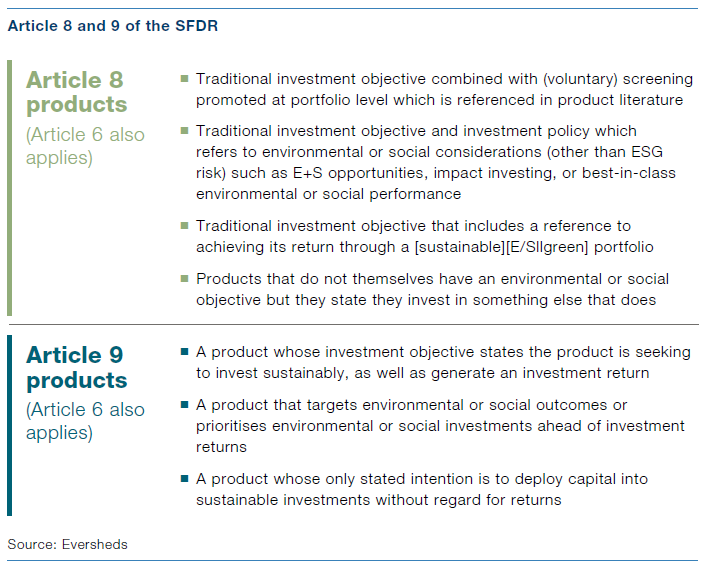
Essentially, Article 8 funds will have some level of broad ESG integration, while Article 9 funds will have specific sustainability targets as the driving force behind their investment mandate. Research from Morningstar in the report ‘SFDR – The First 20 Days,’ which has collected SFDR data on close to 50% of funds (i.e., 5,695) domiciled in Luxembourg, Europe’s largest funds domicile, said preliminary data from 30 asset managers found funds classified as Article 8 and 9 currently represent up to 21% of total European funds and up to 25% of total European fund assets. This means the current European ESG and sustainable fund market, based on SFDR definitions, could therefore be worth as much as €2.5trn.

We have yet to see whether the EU will accept firms’ SFDR definitions, and there will likely be some degree of re-classification as the extent to which regulators require strict adherence to definitions becomes clear. We believe that firms have thus far been relatively circumspect in defining their funds as Article 9 and would therefore anticipate a growing number of Article 9 funds to be classified, both as new funds are launched and as an increasing number of Article 8 funds are upgraded to Article 9.
The UK will not fall under the EU’s SFDR regulation directly, although it is expected that many funds will seek to achieve SFDR compliance. In terms of UK regulation specifically, the government has stated that it intends to make climate-related financial disclosures mandatory for certain firms including occupational pension schemes, insurers, banks and building societies and asset managers by 2025 by adopting the recommendations of the UK’s regulator and the international Task Force for Climate-related Financial Disclosures (TCFD).
The Financial Stability Board (FSB)’s TCFD has seen broad take-up, although it is both voluntary and seen as less rigorous than the EU’s SFDR rules. Chaired by Michael Bloomberg, the TCFD began issuing recommendations to companies to aid them in climate-related disclosure in 2017. These recommendations are voluntary and are in place as guidelines to assist businesses in identifying and sharing both risks and opportunities they face as a result of climate change. In turn, investors, lenders, insurers, and other participants in the market will have a more complete picture when assessing the value of those companies and the risks they face. A goal of the TCFD is to encourage sustainable investments so as to build an economy that is resilient in the face of climate-related uncertainties. The TCFD consists of 32 individual members selected by the FSB from across the world of policy, finance and business.
U.S. financial regulators have been slow to address climate change when compared to jurisdictions such as the European Union and United Kingdom. Only in late 2020, for example, did the U.S. Federal Reserve join the Network of Central Banks and Supervisors for Greening the Financial System (NGFS), an international group focused on climate change risk.
On the securities side, the U.S. Securities and Exchange Commission (SEC) has also been circumspect on climate disclosure. Since the election of President Biden, however, the SEC has formed an enforcement team to focus on disclosures from public companies related to climate change, investment-advisor activities, and funds dedicated to ESG investments. The agency has also published a ‘risk alert,’ which included findings on shortcomings in ESG practices seen at firms during its inspection process.
Chapter 5 Stewardship and Activism
Key Points
-
-
-
-
-
Shareholder activism has been key in driving corporate change.
-
We believe that this will play an increasingly important part in persuading companies to embrace decarbonization.
-
-
-
-
It’s worth recalling a point made earlier in this paper – that ethical investment has long been a fundamental part of the role of financial institutions. It should come as no surprise that it is long-term investors such as pension funds driving the move to more sustainable investment practices. Any consideration of long-term time horizons must now build in a vision of climate change and its potential to significantly and negatively impact the course of human progress. Climate activism has moved from the preserve of a number of specialist funds seeking to drive change through engaging with company boards to the more universal concept of stewardship – investors as asset owners seeking to achieve positive outcomes for a range of different stakeholders.
The Principles for Responsible Investment (PRI) defines stewardship as investor
action that seeks to achieve the following aims:
-
Engaging with current or potential investees/issuers, across all asset classes:
-
Voting at shareholder meetings;
- Filing shareholder resolutions/proposals;
- Fulfilling direct roles on investee boards and board committees;
- Litigating;
- Engaging with policy makers and standard setters;
- Contributing to public goods (such as research);
- Engaging in public discourse and disclosures that support stewardship goals;
- Negotiating with, and monitoring others in the investment chain (e.g. asset
owners engaging with investment managers).
All of these activities have become both more prevalent and widely accepted in recent years, as investors have demanded more of the funds they invest in, and these funds have, in turn, exerted pressure on corporations to set and achieve climate goals.
The graphic below, from NGO SustainAbility, outlines the various different approaches to stewardship when it comes to the environment, listing these modes of engagement from most to least hostile. It should be noted that only a relatively small number of fund engagements with corporations become public; there are many more taking place behind closed doors.

Recent examples of stewardship success stories include ExxonMobil shareholders backing an activist investor, the tiny hedge fund Engine Number 1, that said the supermajor faced ‘existential risk’ because of its focus on fossil fuels. In Australia, BHP withdrew from the World Coal Association as a result of a 2017 resolution, and AGL, a leading energy company, announced that it would tie executive pay to carbon transition measures, which followed a 2019 shareholder resolution.
Proponents of ESG-conscious operations are elaborating new standards and ‘best practices’ related to corporate governance – again, here we find a significant crossover between the various elements of the ESG triumvirate. Most prominently, ESG-conscious investors are looking into how boards and management teams oversee environmental and social performance, how ESG oversight is allocated among board committees, and whether a board has sufficient expertise in environmental and social issues. From the production of sustainability reports to a firm’s subscription to international treaties regarding carbon reduction, shareholders have an increasing ability to drive good – and sustainable – governance.
The Climate Action 100+, the largest ever global investor engagement initiative on climate change, was launched at the end of 2017 and has attracted 615 signatory investors managing assets in excess of $55 trillion. These institutions are pressuring public company managements and boards of directors in several target industries (fossil fuels, mining, etc.) to enact greener policies, increase environment disclosures, and systematically cut their GHG emissions. To date, the Climate Action 100+ claims that more than one in five of its ‘focus companies’ in the fossil fuel, mining, and automotive industries have committed to science-based emission reduction targets.
We mentioned earlier that we are moving from a sustainable investing world dominated by exclusion lists to one in which stewardship takes a much more active and engaged role in driving change at companies. We now have a spectrum of approaches that runs from exclusion to activism, with the pendulum swinging increasingly away from the former and towards the latter. We as engaged investors must be aware of the possibility for greenwashing and hypocrisy here – there is clearly the potential for an element of bad faith to creep into the dynamic. But, if managed in the correct fashion, and in a coordinated and coherent manner, investors have extraordinary power to drive meaningful change at the companies in which they invest. We urge all asset owners to have a stewardship plan that sets out in detail what they expect of the firms they invest in and believe that the investment industry is well-positioned to leave a powerful legacy for future generations in the way it has taken the lead on the climate crisis.
Chapter 6 What Securities are ‘Good’ for the Environment?
Key Points
-
-
-
-
-
What are ‘good securities’?
-
Identifying investments that outperform from an environmental standpoint is not easy; this is a complex and nuanced
-
-
-
-
Introduction
We thought it might be useful to map out our approach to the selection of ‘good’ or climate-positive securities. It’s important to stress that our thinking is constantly evolving here, and that the correct approach to constructing climate-positive portfolios remains a mixture of art and science. We have regular and occasionally heated debates around the subject internally, and so what is presented here is not to be thought of as the last word, but rather an indication of the current state of an ongoing discussion about the difficulties and nuances of security selection in a world where climate will play an increasing and often primary role in asset allocation.
To identify good securities, one needs to know how to spot bad ones. The biggest threat to the environment is the emission of greenhouse gasses, which come from a variety of sources (see chart below). Energy production is the main culprit, which can be divided into energy used by industry, for transport, and in buildings. Iron and steel production (7.2% of total), which often involves the use of coal, deserves a particular mention. As does road transport (11.9%), which explains the push for electric cars. Livestock & manure (5.8%) is a sizable contributor to gas emissions as well, so tilting consumption towards plant-based foods would help reduce emissions.
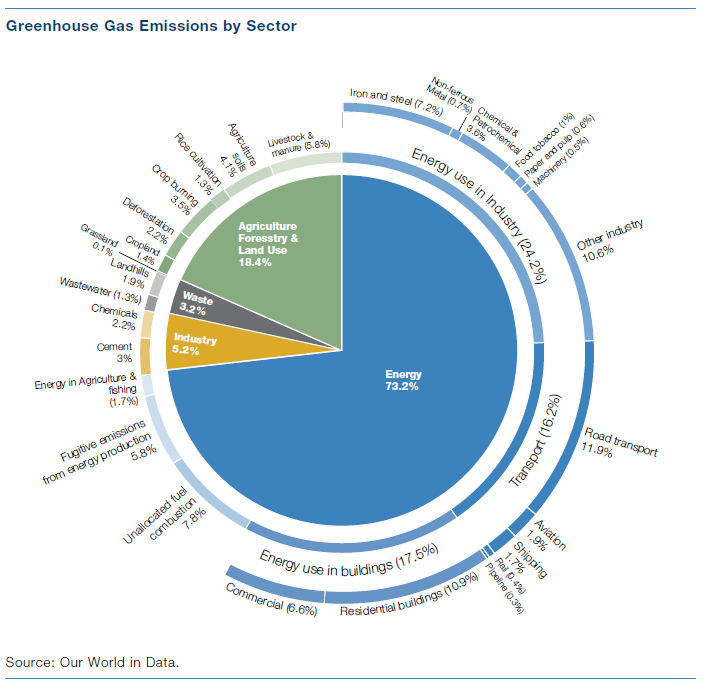
In this section of the White Paper we explore whether securities from a wide range of asset classes are good from an environmental standpoint. It’s a situation painted in shades of grey, with a host of indirect effects, easy-to-overlook nuances, and shifting dynamics (technological advances, policy changes, etc.). We are therefore the first to admit that this chapter will be just a scratching of the surface, and welcome feedback and further discussion. However, we cannot let the complexity of the topic persuade us not even to attempt to shed light on it. Climate change is too important for that.
For each assets class, we comment on the mechanism by which investing in good securities helps with the transition to a low-carbon economy. The direct impact varies from lowering the cost of capital for stocks and bonds, financing climatefriendly projects in case of green bonds, facilitating functioning markets for key commodities, helping to share the risk of extreme weather by including catastrophe bonds, and (perhaps most direct of all) reducing the carbon budget available to polluters with a buy-and-hold physical EU carbon credit investment.
An important indirect effect is that by cheering on some companies and securities, and shunning others, the investment community exerts pressure. Company boards don’t just factor in their cost of capital, but also a rich set of interactions with other stakeholders, like employees, regulators, and customers, and for this a company’s climate or ESG credentials likely matter a lot. Similarly, using a commodity on the naughty list can have reputational ramifications. Hence responsible investing helps create a firm message in the ‘Zeitgeist’: that urgent action on climate change is needed.
We start our discussion with stocks, for which a plethora of data is available. Those data are often conflicting and inconsistent. We argue for using data sources that are holistic (capture production and utilisation effects) and tap into multiple highquality data sources.
1. Stocks
-
Stock markets are where we find the most information about companies via annual reports and analyst views.
-
ESG data can be complex and contradictory.
- How do we harness this data to select the most sustainable stocks?
1.1 How to Use ESG Data to Select Good Stocks
We have discussed above the baffling array of ESG data vendors and their sometimes contradictory ratings. This begs the question as to whether it is possible to use ESG data to establish which stocks are good for the environment? We argue for an approach that makes uses of the plethora of available data in the following manner. Firstly, determine what aspect of ESG matters to you. For this paper, that means a focus on the E(nvironmental) score, or (more narrowly) the climate-related aspects of the E in ESG.
Secondly, we suggest using data sources that take a more holistic view: for example, in the case of Tesla that would mean also incorporating in your analysis the fact that their products help to move people away from polluting combustionengine cars, and not just looking at the pollution produced by their factories. This point will return when we consider other asset classes, and particularly in the case of commodities, which invariably are harmful to the environment to produce, yet many play a key role in the transition to a low-carbon economy.
Thirdly, diversification is also beneficial in the context of data, meaning that we consider it sensible to average the ratings of multiple (high-quality, holisticallyoriented, E-focused) data providers. One may see this as a form of tapping into the wisdom of the crowds, as different people working at the various data providers may have their own unique insights. More sophisticated investors will create their own proprietary climate models, which combine third-party information with the firm’s own analysis.
As investors move from exclusion lists to more integrated and engaged climate strategies, we believe that there will be a concomitant increase in the sophistication of portfolio construction and analytical tools, allowing investors to specify more precisely the stocks they wish to select and those they want to avoid. Furthermore, companies will increasingly have to report more data about the various scopes of their emissions, so that investors will be much better able to get a picture of the climate damage done by a firm’s entire ecosystem, as well as the steps the company is taking to mitigate this harm.
1.2 ESG Equity Index Futures
Many investors prefer to take exposure to a broad baskets of stocks, like the S&P 500, rather than selected individual companies. Investors seeking to ensure that they invest sustainably might still want the convenience of index exposure, while filtering out a handful of companies that are deemed bad for the climate or have a low ESG score. If you don’t want to invest in the physical constituents of the basket, you can ask a bank to create a return swap on your basket of choice. The bank, of course, will charge you for this service. Also, it creates a level of dependency with the bank, including having some counterparty risk.
An alternative is investing in one of the recently introduced exchange traded ESG futures. These futures reference selected equity indices, such as the S&P 500, Eurostoxx 600, and Swedish OMX 30 index, with adjustments made to exclude firms that are viewed as incompatible with an ESG-focused investment strategy.
Companies might be excluded for several reasons. Berkshire Hathaway (S&P500 member) could be excluded as, according to several of the major raters, it lacks proper reporting on environment and social issues. Moreover, Berkshire Hathaway gets penalized for its governance, because the board has a relatively low fraction of independent members. Other examples of exclusion from the ESG futures are Netflix (S&P 500) for having a low UN Global compact score, Airbus (Stoxx Europe 600) for its controversial weapons production, and Evolution Gaming (OMX 30) for operating in the gambling industry.
These are new contracts, and liquidity is still limited. However, there has been a steady improvement in terms of volumes and open interest. The exhibit below shows volumes and open interest for the S&P 500 ESG future.
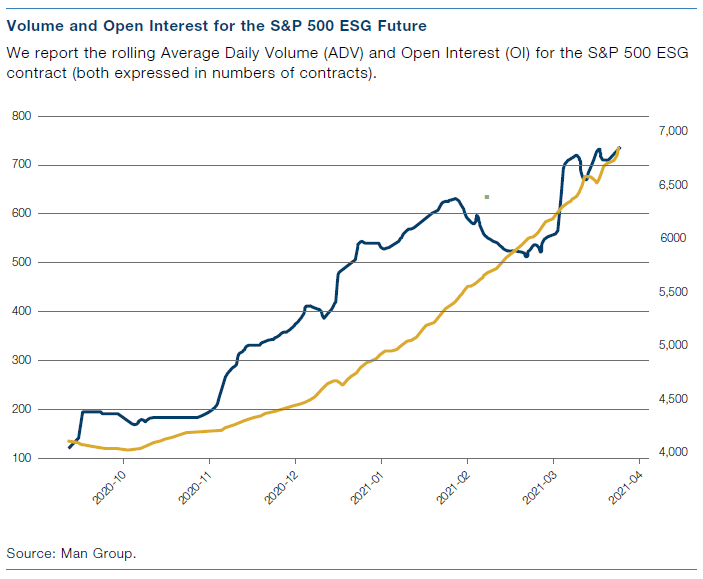
2. Corporate Bonds
-
Green corporate bonds require much of the same analysis as green stocks.
-
There are an increasing number of ratings that look specifically at the sustainability of debt.
- Green and sustainable bonds have been issued by a wide range of corporations globally.
In principle one can extend any climate or ESG view on a company’s stock to the corporate bonds issued by the same entity. That said, one company can issue many different corporate bonds, varying in terms of duration, seniority level, etc., which may necessitate ad-hoc adjustment to be made to incorporate ESG considerations properly.
ESG has not yet impacted the world of fixed income to the same extent as the equity markets. At the end of 2019, only around 20% of global ESG-related investments were in fixed income. Partly this is a facet of the fact that shareholders have voting rights and usually greater ability to influence management behaviour. There is also the potential of significant upside for the shareholders of those firms who can turn the current focus on ESG to their advantage. However, we still believe that ESG will increasingly become an important consideration for fixed income investors as the credit risk associated with them grows: ESG impacts the whole enterprise value not just the equity. Initially there will be inevitable spillover from the equity markets, where ESG considerations are increasingly driving corporate behaviour. Longer term, we believe ESG risks will be considered as part of credit risk. There’s also the fact that ESG investors in credit have the ability to effect positive change in companies who do not have publicly-tradable equities – the vast and increasing world of firms with private equity but public debt.
The chart below, from Invesco’s Fixed Income Survey, shows the striking rise in respondents who are incorporating ESG metrics into their credit funds.
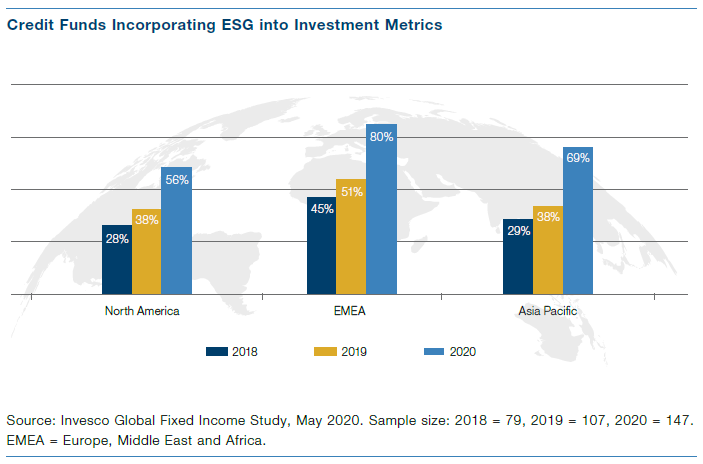
The identification and management of ESG-related risks is a form of enterprise risk management. We believe that it will increasingly be the case that firms who fail to address environmental, social and governance issues face being punished by their customers, regulators and investors. This may have significant ramifications for bondholders with the potential for such events to have a material adverse impact on a firm’s credit quality. We are already seeing increasing recognition from credit ratings agencies of the magnitude of potential ESG-related incidents and their ability to impact a company’s credit profile. With the advent of green bonds, ESGfocused fixed income funds that go beyond mere exclusion lists, and an increasing availability of ESG-related tools and data, we expect to see continued interest and growth in ESG-focused fixed income in the coming years.
It’s worth thinking about the dynamics of distressed bond situations, where often bondholders have significantly greater power than equity holders and are in a unique position to insist upon positive environmental changes as a company emerges from administration. Distressed investors have thus far been below the parapet as far as ESG goes. You can understand why: there are clear commercial sensitivities to their negotiations and it tends to be a secretive section of the markets anyway. Furthermore, you can understand why the white-hot pain of corporate distress may historically not have been the best forum to bring up ‘softer’ issues like sustainability. We believe that this will change, though, as more funds embrace ESG and activist ESG funds move into the distressed debt space.
2.1 The Advent of Green and Sustainable Bonds
ESG-labelled debt is issued to finance projects with a specific ESG focus. Such debt was virtually non-existent in 2013, but has been on a meteoric rise since then, as the exhibit below illustrates. Initially the focus was almost exclusively on green bonds, which are used to finance projects linked to climate or environmental themes. These can be issued by supranational organizations, governments, and corporates. Subsequently also social, sustainable, and sustainability-linked bonds have become more commonplace. These bonds are broader in scope than green bonds, by having a more general sustainability or ESG objective, which means that also companies that don’t naturally have projects suitable for green financing can participate in sustainable finance. As Flammer (2020) notices, for the issuer, the benefits may go beyond financing, as issuing a green bonds acts as a signal to the market that the issuer is committed to the environment.(11)
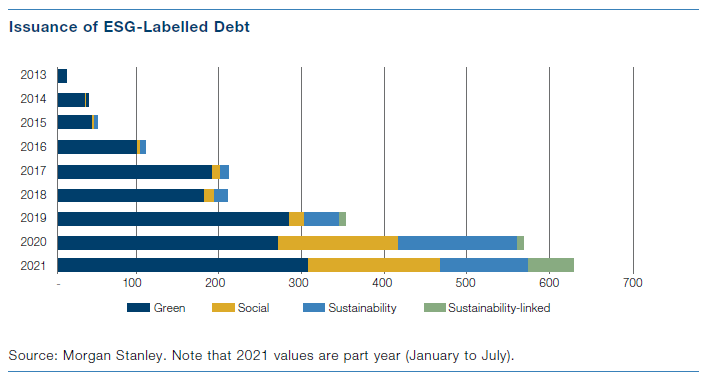
2.2 Examples of Green Corporate Bonds
Corporate debt accounts for about half of all green bond issuance, with Sovereigns, Supranational and Agencies (SSA) being the other big category. The chart below shows the different types of corporate green bonds outstanding and how the capital raised is then deployed.
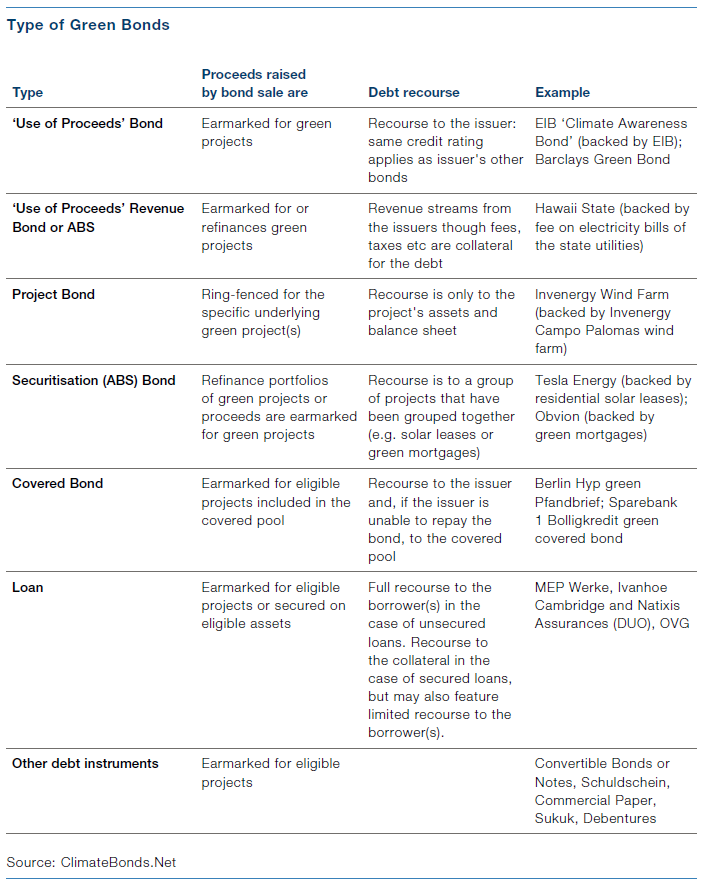
Green bonds have been issued by a wide number of different corporations for a variety of different purposes. We have seen particular issuance from European companies in the communications and financial services industries, while utilities are increasingly issuing sustainability-linked bonds (SLBs). Recent issuers of green bonds range from Berkeley Homes in the UK to Deutsche Bank in Germany, while Apple issued a $1bn SLB in May 2021.
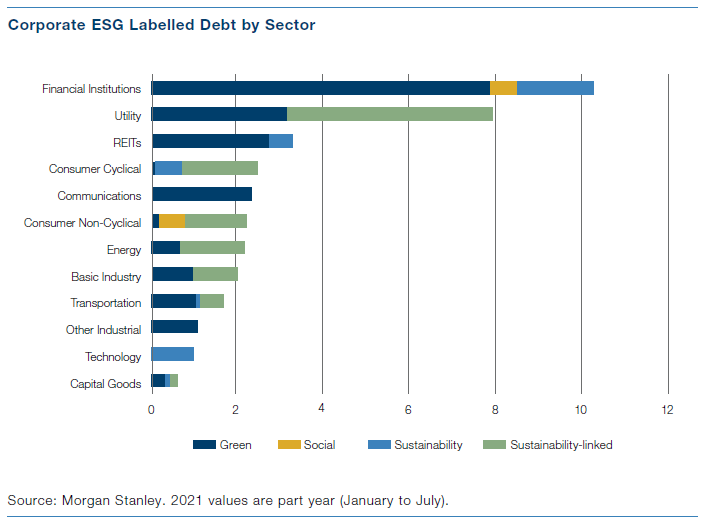
To prevent ‘greenwashing’ – companies simply claiming adherence to green principles without backing it up with actions – organization that provide a control function have sprung up. One is the not-for-profit Climate Bonds Initiative who developed the Climate Bonds Standard and Certification Scheme and are supported by HSBC.(12) In the exhibit below, from their 2019 ‘Green Bond Global State of The Market’, we observe that the proceeds of green bonds are mostly used for energy (efficiency and renewable), green buildings, and clean transportation projects.(13)
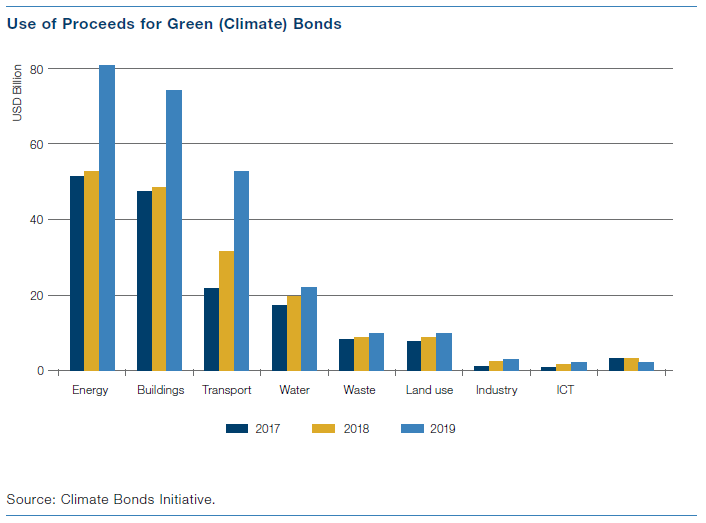
3. Government Bonds
-
Following the surge of company-level ESG metrics, country-level (sovereign) ESG scores have been a subject of increasing focus.
-
The most logical instrument to link to sovereign scores is a country’s Government debt, as investing in it essentially helps a Government finance its operations.
- Credit rating agencies, such as Moody’s and S&P have signed up to the United Nations Principles for Responsible Investing (UN PRI) and by now include ESG aspects in their credit reports.
For sovereign issuers, ESG rating agencies have developed country-level indices focusing on the long-term sustainability of the respective country’s economy. A set of ESG scores for sovereigns is also produced by the World Bank. These provide information on 17 sustainability themes reflecting the 17 Sustainable Development Goals from the United Nations. We reproduce the monitored themes in Figure 17.
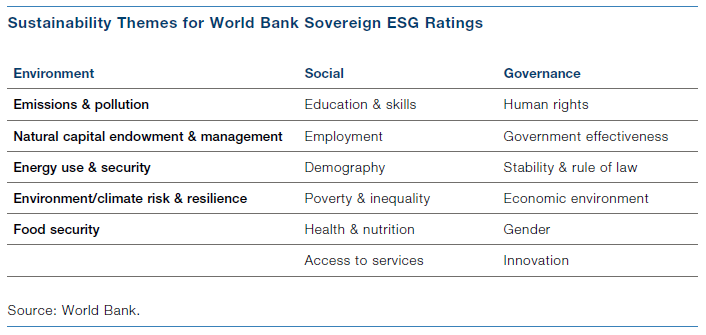
In a recent report, Bank of America introduced a methodology for ranking 34 developed and emerging countries, together accounting for about 80% of the world’s GDP.(14) Their score is based on 25 attributes for the following six indicators: (1) climate change; (2) biodiversity and land; (3) innovation; (4) health; (5) people; and (6) governance. The summary results are presented in the table below.
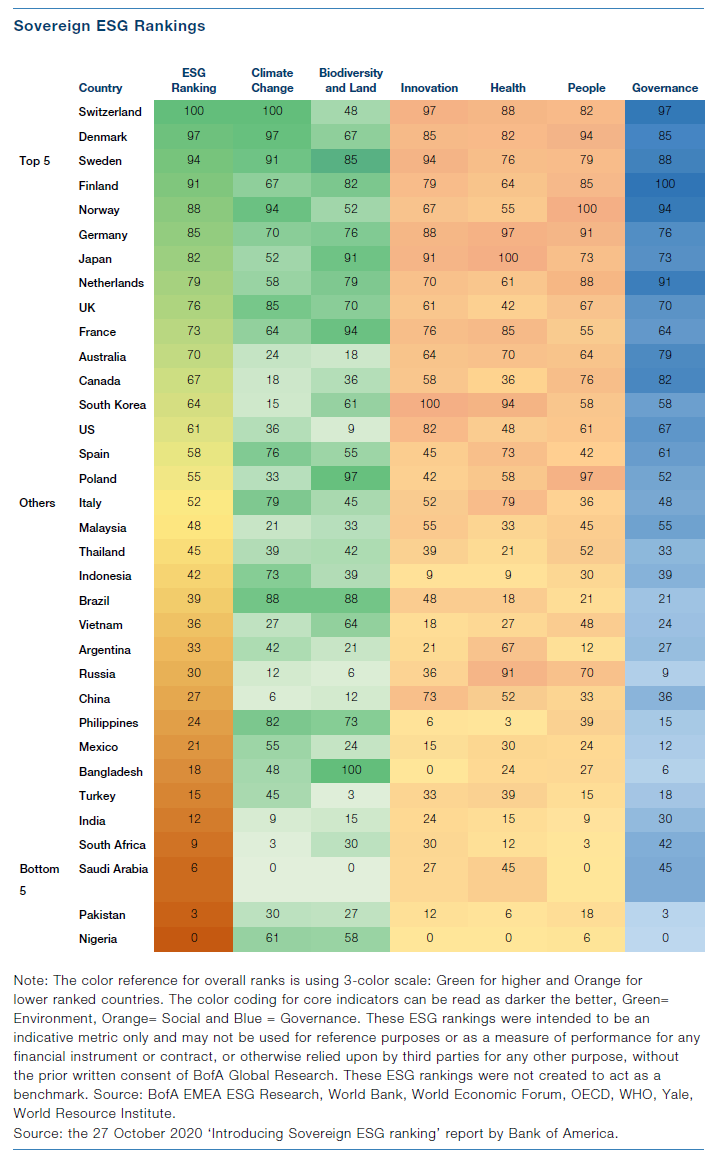
Several observations can be made concerning sovereign ESG performance, where we will mostly focus on the climate change score and the overall ESG ranking. Firstly, developed countries, with higher GDP per person, tend to rank higher than emerging market countries. Developed countries have more leeway to focus on the environment, are more advanced in their clean technologies, and tend to rely less on fossil fuels for power generation.
Among less-developed nations, there is still considerable variation in the climate and overall score. European countries rank highest, as Europe is clearly at the forefront of fighting climate change. The US is at the bottom of the pack, which is due to their high waste per capita and poor water management. The low US ranking is not directly due to the temporary withdrawal from the Paris Climate Agreement under former President Trump, as the US continued to target greenhouse gas emission reductions consistent with the Paris Agreement.
4. Other Asset Classes
We will now look at a range of other asset classes and the extent to which they have engaged with climate positive investment. While the large private equity houses have at least gestured towards the necessity of ESG-compliance, it’s clear that at least one element driving the boom in public-to-private deals in recent years has been the fact that private companies are not subject to the same levels of scrutiny or public pressure regarding their performance – both financially and nonfinancially. There are sustainability success stories in the industry. Goldman Sachs’ buyout arm backed the wind farm strategy of Orsted as it moved away from oil and gas, for instance. But the overall picture is more negative.
A recent analysis by consultancy Bain admitted there was ‘scepticism’ about ESG investing in the private equity industry, although it highlighted other positive stories, such as the overhaul of Polish convenience store chain Zabka, owned by CVC, which led to substantial cuts in plastic waste and CO2 emissions, and a boost in plant-based food sales. These, though, are exceptions to the rule, and private equity firms need to do more to persuade a sceptical public that gestures towards ESG are anything more than that. Given the scale of the private equity industry and its importance to global markets – remember that many of these firms will eventually return to public ownership – we believe this ought to be an area of significant focus going forward. As with elsewhere, Europe significantly leads world in encouraging its private equity firms to embrace environmental pledges and disclosure.
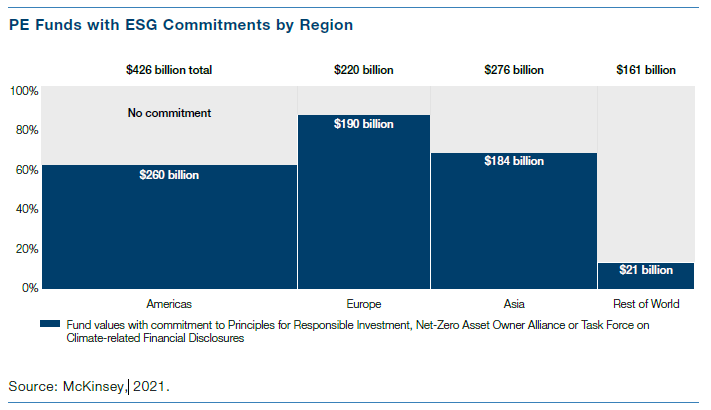
Impact investment in housing is already a well-established subset of responsible investment. Although usually social goals are the driving force behind these strategies, sustainable building is an area of growing significance. A Bank of England paper published in April 2021 entitled ‘Climate Policy and Transition Risk in the Housing Market’ outlined the challenges and opportunities for the sector in the UK. It noted that housing accounted for around 15% of greenhouse gas emissions and that the building trade had been slow to adopt more sustainable building methods. It highlighted the importance of regulation in driving improvements to practices and the necessity of ensuring that lower-cost housing did not always mean less sustainable housing.
We’ve noted several times the overlap between the various elements of ESG and it’s in housebuilding that these are seen at their most pronounced. More sustainable homes are better homes and must be available to all. It’s clear that the industry is waking up to this reality and, at least among listed house builders in developed nations, there appears to be a growing recognition of the importance of building with an eye to long-term sustainability as well as profitability. Again, this may be down to the fact that these companies rely on sourcing capital from more enlightened institutions that have made clear the focus they put on sustainability.
Cryptocurrencies might have been designed to raise the blood pressure of climate campaigners. The way bitcoin and most other cryptocurrencies operate today rewards energy waste. To generate new coins, miners around the world operate fleets of computers that compete against one another to crack increasingly difficult mathematical problems. Because of that escalation, miners have an incentive to work around the clock and operate as many computers as possible. The end result: globally, bitcoin mining consumes about as much electricity as the nation of Finland, with a carbon footprint comparable to that of the London metropolitan area.
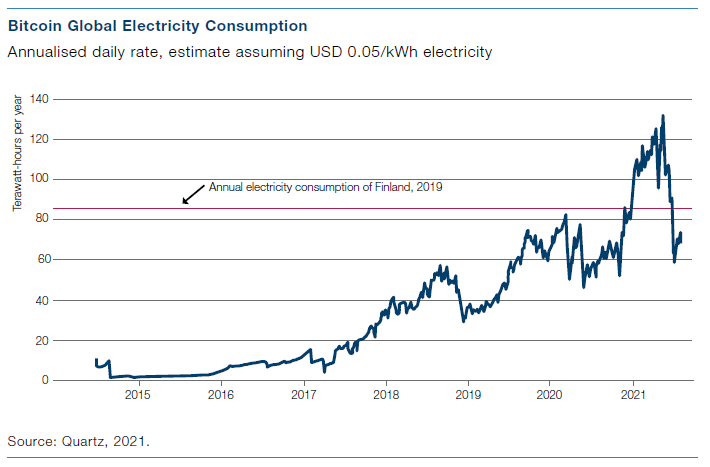
5. Commodities
-
The production of most commodities is harmful to the environment.
-
Commodities, though, are necessary to life. We must therefore take a nuanced view on commodities, one that factors in both production and utilization, as well as ascertaining the range of possible alternatives to each commodity.
Commodities are, if you’ll pardon the pun, at the coalface of the ESG movement. The mining industry is responsible for some of the worst environmental degradation globally, is a significant contributor to deforestation and responsible for around 7% of global GHG emissions. Commodities, though, are vital for the transition to a lowcarbon economy, with lithium, graphite, nickel, manganese and cobalt all crucial components of electric vehicle batteries. The chart below shows how dramatically the demand for nickel has grown as electric vehicle manufacturing has taken off.
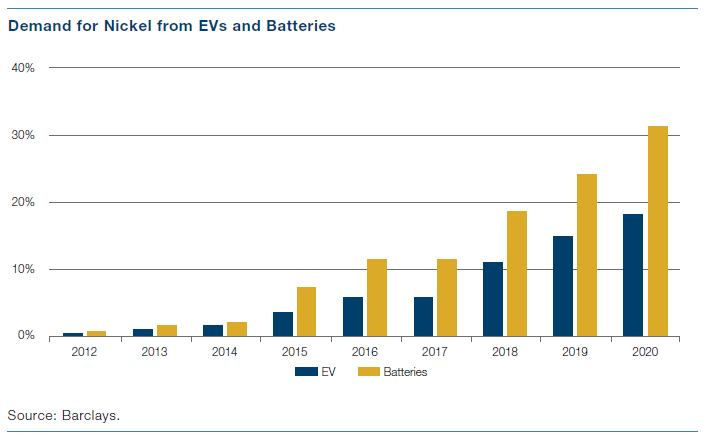
The mining industry has taken steps to improve its reputation when it comes to sustainability, with Rio Tinto, for instance, tying 15% of executive pay to ESGrelated goals. It is clear, though, that commodities remain problematic from an ESG investment perspective, requiring a nuanced approach and a significant amount of analysis to differentiate between the good and the bad in the space.
5.1 What Should we Eat?
About a quarter of greenhouse emissions comes from food production, as shown by the figure below.(15) Transportation and packaging account for just a small portion of the food-related greenhouse emissions. The bigger question is what type of food is good for the environment. That is, what should we eat?
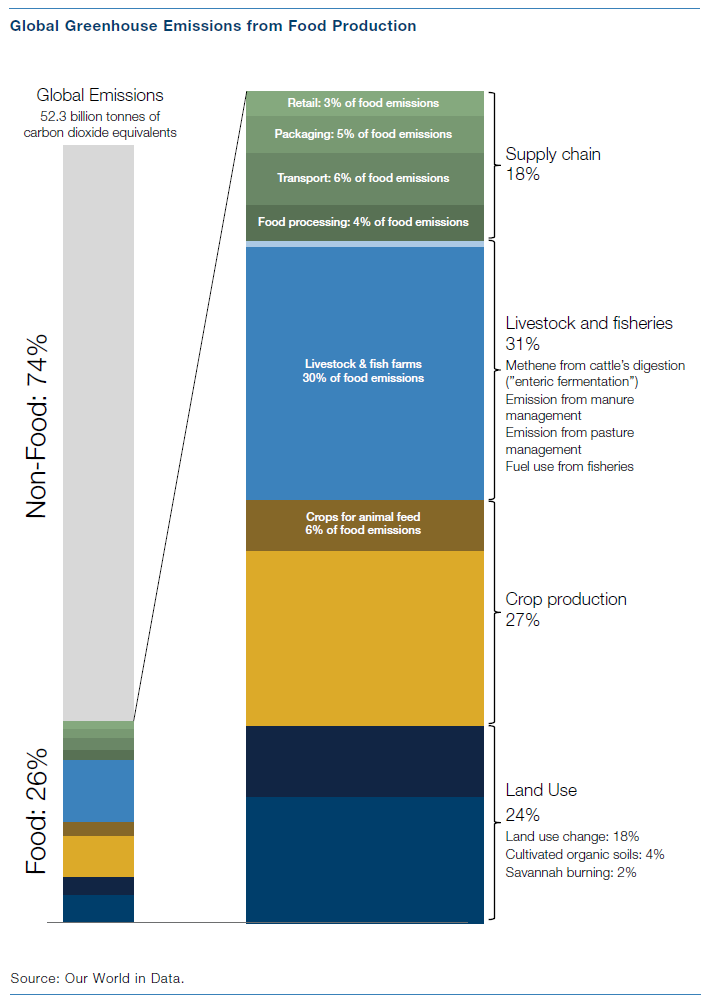
The greenhouse gas footprint of plant-based products is typically much lower than the footprint of animal-based products, as illustrated below.(16) Methane production by cows makes beef a very greenhouse gas-intensive food. Also, chocolate ranks high in terms of emissions, as cocoa production is often associated with deforestation and forest degradation.
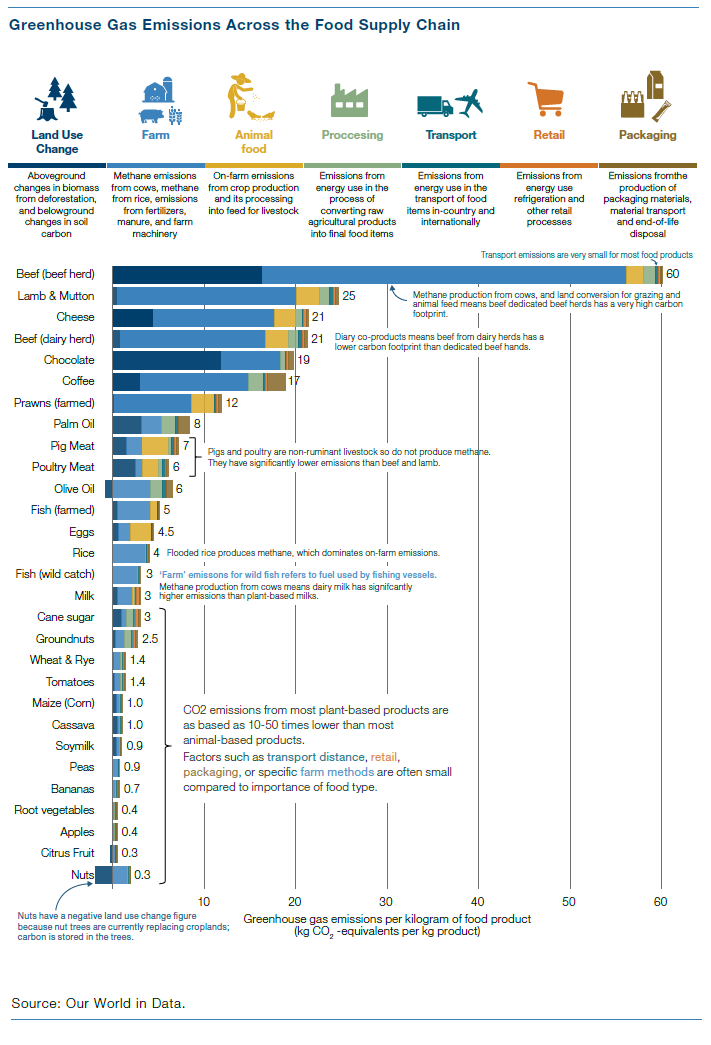
Investors need to think about how they structure both their investments in commodities and in the stocks of commodity producing and trading firms. Nuance lies not only in understanding the difference between production and utilisation, but also in the myriad ways that investors might find themselves exposed to commodities in their portfolios without this being immediately clear to them. For instance, they may have investments in banks that help finance intensive cattle farming operations in Brazil, or in a conglomerate that has significant exposure to chocolate production.
5.2 How Should we Move Around?
Is it more harmful for the environment to produce an electric car, or a petrol, or a diesel car? The answer may surprise you: producing an electric car (and its battery) is typically more harmful.(17) However, the subsequent use of electric cars is obviously more environmentally friendly, even under current carbon intensities of electricity generation, which often involves fossil fuels.(18)
The fundamental difference between conventional, combustion-engine cars and electric cars has to do with the process of transforming the potential (stored) energy into kinetic (movement) energy. In combustion-engine cars, this energy is stored in a chemical form and is released through a chemical reaction inside the engine.
On the other hand, despite also having chemically stored energy, electric cars release it electrochemically without any kind of combustion, thanks to lithiumion batteries. This means that there is no fuel being burned and therefore no air pollution through CO2 happening while driving. They are also more efficient than fossil fuel-powered cars.
If the source of energy to power these cars doesn’t come from solar panels, wind turbines or even nuclear or hydroelectric, their CO2 emissions will be much higher. For instance, if the electricity used to charge cars comes from the burning of fossil fuels, it doesn’t matter if the EC are not polluting while being driven, as this pollution was already released in some distant power plant.
This means that if you’re driving an electric car in the US, where fossil fuels accounted 62.7% of the country’s energy production in 2017, you’ll probably release more CO2 into the atmosphere than if you’re driving it in Iceland, that runs almost entirely on hydro, geothermal and solar energy.
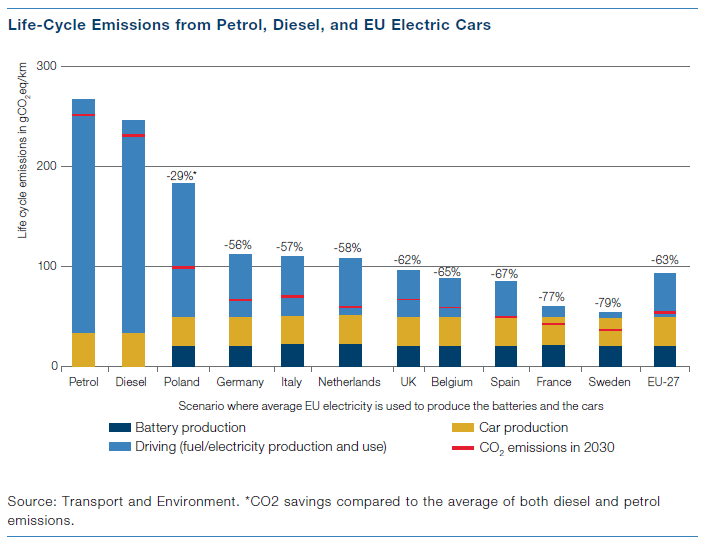
Turning specifically to metals, several key metals are important for electric car (and battery) production. So even though mining those commodities is harmful in and of itself, they are needed to transition away from combustion-engine cars. This includes commodities such as copper, nickel, cobalt, and lithium. Platinum and palladium are key for vehicle catalytic converters designed to reduce harmful emissions for those engines still using petroleum.
5.3 How to Power Ourselves
We look here specifically at the role of coal in our economies, given that coal is by some distance the most harmful fossil fuel. Coal’s primary use is as fuel to generate electric power.(19) There are increasingly cost-efficient alternatives for coal when it comes to electric power generation, like solar and wind energy. The secondary use of coal is in the production of steel, where finding a viable alternative is harder. Steel production accounts for around 8 percent of global carbon dioxide emissions, and so addressing this more complex challenge is important.(20) Alternative steel production methods are being explored, as the exhibit below from a McKinsey report on the topic illustrates.(21)
To produce steel one needs coking coal, which is of higher purity than the thermal coal used in energy generation. Coking coal is heated to remove other chemicals resulting in near pure carbon, called coke. The coke is combined with raw iron ore in a blast furnace to create pig iron. All in call coal plays three roles in the production of steel: as reducing agent to produce pig iron, a source of energy, a source carbon for the final product (steel is an alloy of carbon and iron).
Alternatives for each of the three roles are available but not always competitive, and often the alternatives are not fully clean either. But the technology is developing. And any scrap steel that can be sourced can be turned into new steel at a competitive rate, hence recycling seems part of the solution.
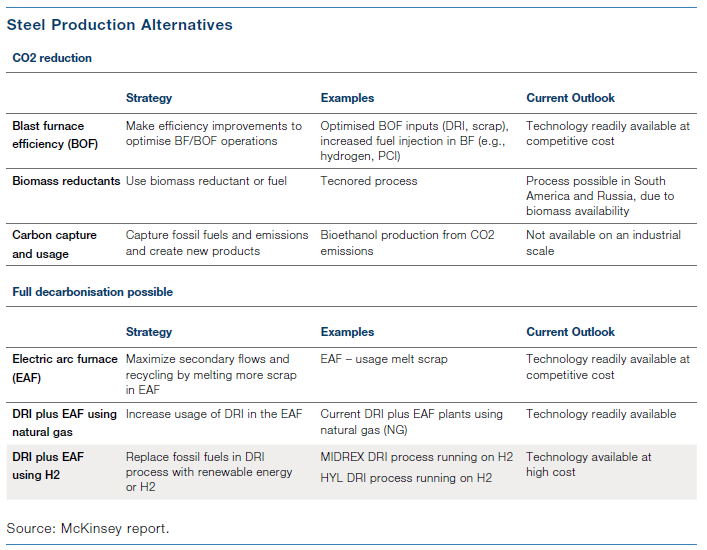
5.4 How to Trade Commodities Sustainably
The French bank SocGen partnered with RFU, a sustainability consulting firm, to provide an innovative and comprehensive ESG rating framework for all commodities futures included in the BCOM index, as shown in the exhibit below. We note that energies have a bad (very negative) score. Base metals score high (not so negative) as they often have powerful use cases. Among softs, cocoa (primarily used chocolate) has the most negative score. Grains have better score than meats (lean hogs and live cattle). Silver is less negative than gold, as silver has more industrial uses than gold.
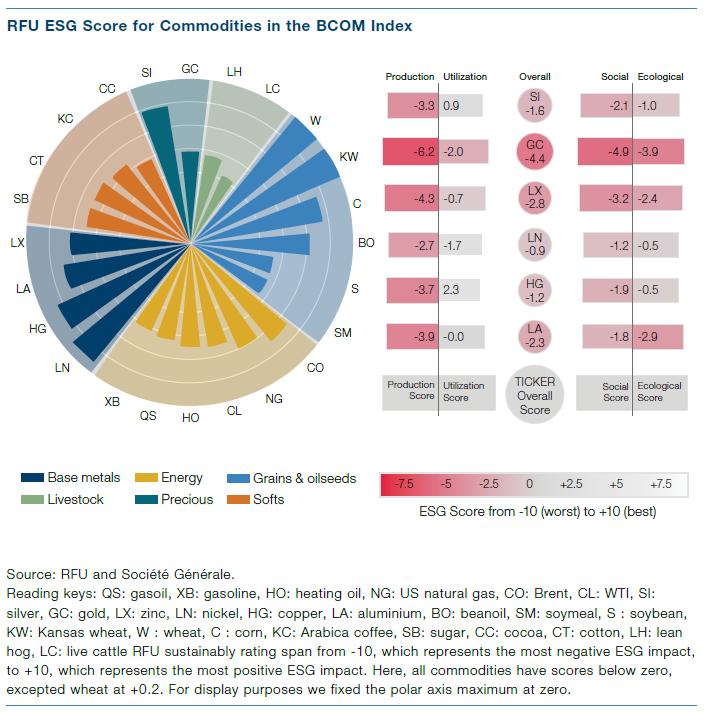
The overall (net) score factors in both social and ecological aspects. In this paper, our focus is more on the ecological aspects. From the last column of the table below, one can see that a focus on ecological (rather than social) scores benefits several metals, notably copper, nickel, palladium, and platinum, which are all important for the transition to clean cars. Also, silver has important industrial uses, including in photovoltaic solar cells. Gold on the other hand has fewer industrial uses. Energies and meats look even worse on just their ecological score.
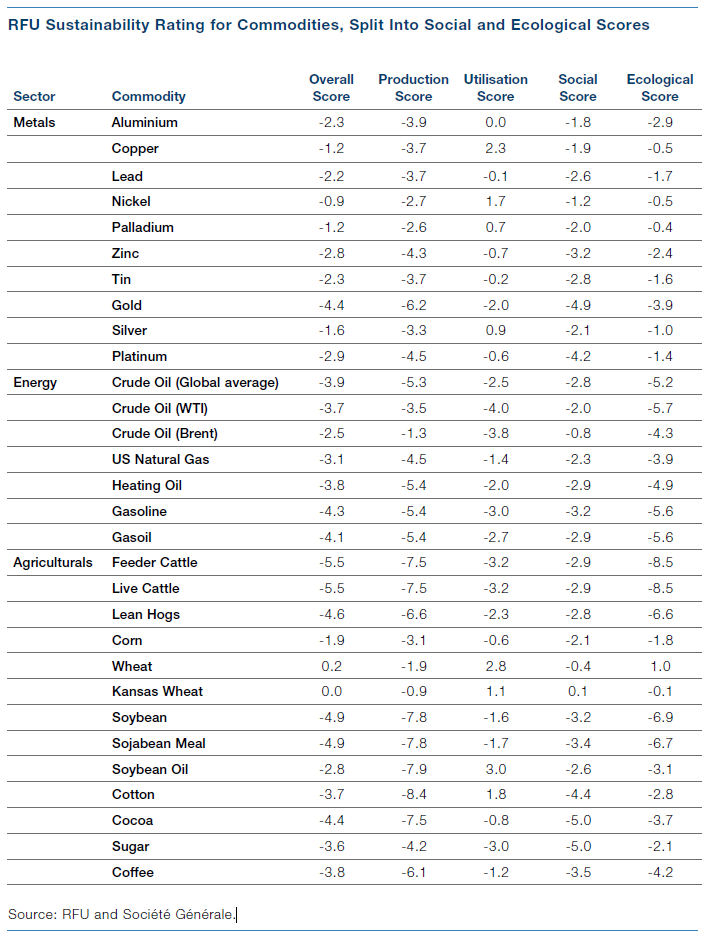
Investors often get exposure to commodities via futures contracts, rather than holding physical commodities. Before a contract expires, the position is rolled to the next contract, so that the investor at no point in time holds the physical commodity.
Some would argue that investing in rolled futures contracts has no (positive or negative) impact on the environment, because the physical commodity is not touched. Moreover, futures contracts are in zero net supply, as for very buyer there is seller of the contract. There are at least three counterarguments to such a view. Firstly, going long a futures contract can put upward pressure on the price of the commodity. If the commodity is bad from an environmental point of view, the higher price may induce greater production of the commodity. Secondly, futures are often helpful as hedging instruments for the economic players for the commodities markets So investing in a bad commodity helps the market in that commodity function and share risk efficiently. Thirdly, investing in a bad commodity may signal acceptance of the market.
6. Carbon Credits
-
Carbon credits are one way in which regulators are managing the transition to net zero.
-
So far there is little joined-up thinking globally; we expect this to improve over time.
Increasingly, many countries have introduced a form of carbon pricing, with the aim of charging companies for the external costs of carbon emissions. Instead of dictating who should reduce emissions and by how much, carbon prices leave it up to the marketplace to decide whether to discontinue polluting activities, reduce them, or to continue and pay the (carbon emission) price. In many countries, carbon pricing is implemented via a carbon tax at levels set by the Government. Some countries, however, have instead set up a system with tradable carbon emissions, allowing asset managers to play a direct role in the pricing (and production) of carbon emissions.
The EU’s Emissions Trading System (ETS) was set up in 2005 by the EU to combat climate change and covers about 40% of the EU’s greenhouse gas emissions, including those of power plants and aviation within the European Economic Area.(22) The EU carbon credits account for the lion’s share of the global carbon market currently.
The ETS operates with a ‘cap and trade’ principle. The total amount of greenhouse gases that can be emitted by companies and sectors in scope is capped. Allowances are added with an auction. Companies that are in scope must surrender allowances to cover their previous year’s emissions. The cap is reduced over time, and so emissions are pushed down over time as well.
Allowances can be traded, among companies and other parties. Allowances can also be saved for a later date, which happened when economic activity slowed down following the 2007-2009 Global Financial Crisis. The resulting glut of allowances lead to relatively low carbon credit prices in the 2012-2018 period, see the exhibit below.
The EU has worked to tighten the carbon market, and in 2019 introduced the Market Stability Reserve (MSR). Supply is tightened if the prior-year total number of allowances in circulation (TNAC) exceeds a threshold, and instead some of the planned new allowances are put in a reserve. From that reserve, allowances can be permanently cancelled if it grows beyond last year’s auction volume. With this procedure in place, an investment in carbon credits by an asset manager can reduce the issuance of subsequent carbon credits, and so have an impact, even if the carbon credit is sold again after some years. This contrasts investment in carbon credit futures contracts where the net supply of carbo credits is not directly impacted.
The EU has committed to the above mechanism and may welcome the recent rise in carbon credit prices. That said, if the recent surge in responsible investing leads to asset managers hoarding carbon credits to the point that companies cannot obtain carbon credits at any reasonable price anymore, one can imagine the EU will step in and increase the supply after all.
It’s also worth considering how the EU can operate its Emissions Trading System in a broader world where companies may not be held to the same standards. The EU put steps in place for companies not simply to move out of the EU’s ambit, including plans for a carbon tax on imported carbon-intensive products, and more lenient treatment for products exported to the rest of the world, so as to not foster unfair competition.
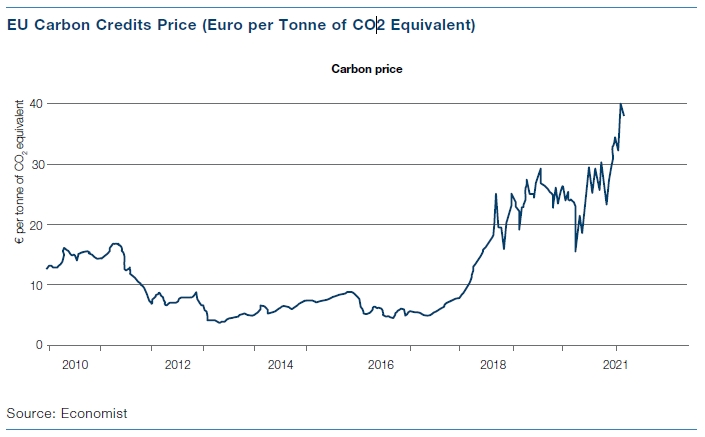
7. Cat bonds
-
Cat bonds help companies and insurance firms spread the risk of natural disasters.
-
With more extreme weather events expected, cat bonds will play an increasingly important role in the capital markets.
Natural disasters tend to hit a specific area while leaving others largely untouched and so are a logical candidate for risk-sharing via insurance schemes. However, a natural disaster can hit so hard that even insurers can go bust, as was the case following the devastating 1992 Hurricane Andrew that devastated the coast of Florida. To address such shocks, reinsurance has become more commonplace, and from the mid-1990s insurance and reinsurance companies have issued cat bonds to offload and spread the risk of disaster more broadly.
Natural disasters are likely to hit more frequently, as the globe warms up and the weather becomes more erratic. Something that was noted as well in the 2021 IPCC assessment report on climate change.(23) As such, cat bonds have an important role to play in sharing the risk of climate change.
7.1 Cat bonds basics
Catastrophe (‘cat’) bonds are securitisations of insurance risk. The market cap of public cat bond deals has grown from less than $1bn in 2003 to more than $34bn today(24).
There are three main parties to a typical cat bond deal: the insured (who is buying insurance cover); the legal entity which issues the cat bond (and holds the bond collateral, i.e., the proceeds from the bond sale); and the investor (who is writing insurance risk). See the exhibit below. Key parameters of a cat bond include its term (typically 3 years); the peril (e.g., wind and flooding damage from a hurricane) and the covered area (e.g., Florida).
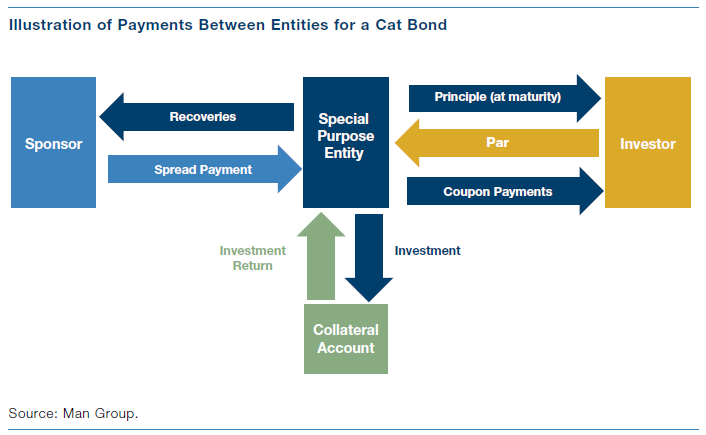
The broad performance of the space can be readily monitored via two main indices. The Eurekahedge ILS Advisors Index is an equally weighted index of 34 funds (and hence is net of fees) and has data since 2006. The Swiss Re Cat Bond index is a market-value weighted index of cat bonds, excluding life and health bonds. It is gross of fees and transaction costs and has data since 2002. Below we contrast the performance of these indices with global stocks and bonds. The performance of cat bond indices has been relatively steady in the absence of major event, with the occasional sharp drop when major events do occur. The last clear example of that was 2017 when several major hurricanes hit the US (Harvey, Irma, Maria). This performance profile is quite different from other asset classes, as also evidenced by a modest correlation between these cat bond indices and global stocks and bonds of only 0.1 to 0.2.
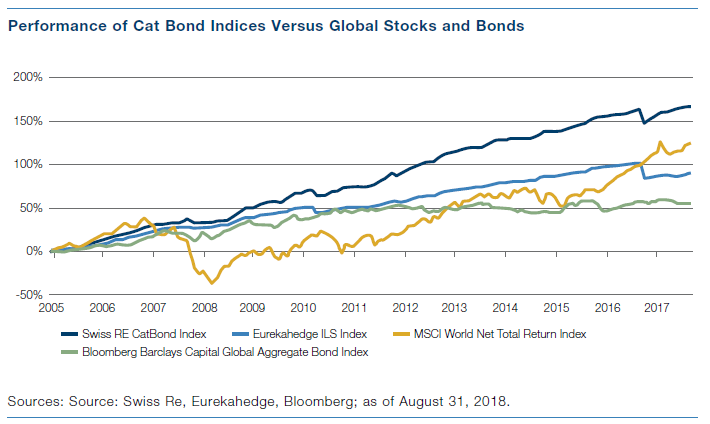
7.2 Climate and ESG merits of cat bonds
When assessing the ESG merits of cat bonds, it makes sense to consider the peril; the insured; and the use to which the collateral is being put.
Over time, we have seen cat bond perils including quake, wind, fire, flood, mortality, morbidity, pandemic, longevity, lottery payouts, industrial accident, credit reinsurance, operational risk, and terrorism. In time, this list will likely extend to include cyber attack and others.
Some perils don’t jive well with an ESG objective. For instance, to offer lottery payout insurance is to support the gambling industry. Similarly, to buy longevity risk is profit from the early death of the policyholder and so may not deserve the predicate ‘good security’. Other perils (such as credit reinsurance, operational risk and terrorism) are of a ‘business continuity’ nature and we therefore consider ESG-neutral.
The remaining core natural catastrophe and life and health perils all provide resilience against disaster. Sometimes the benefit flows through a corporate insurer, on other occasions the benefit flows through a government mandated insurer or benefits the state itself. For example, the Turkish Catastrophe Insurance Pool was set up by the government to source and supply affordable earthquake cover, and to reduce citizens’ dependence on the government to finance rebuilding. And with the assistance of the World Bank, the Pacific Alliance countries sourced quake cover in order to ‘increase countries’ … resilience to natural disasters … without increasing sovereign debt’.(25)
When a cat bond is issued, the legal entity issuing the bond holds (and invests) the proceeds. Usually, the investment is in highly rated money market funds, but sometimes the proceeds are used to purchase a supranational note (or the issuer itself is a supranational, in which case the bond proceeds are directly available for use). A recent IBRD issue for Jamaica illustrates a trend, whereby ‘The net proceeds from the sale of the Notes will be used by IBRD to finance sustainable development projects and programs’(26). Thus the cat bonds serve a double ESG purpose – to provide resilience to the insured, and to apply the bond capital to sustainable projects in the meantime.
(1) This topic has been addressed in compressed form in Desmyter, S. ‘Winners and Losers in a Warming World’: https://www.forbes.com/sites/stevendesmyter/2021/09/10/ winners-and-losers-in-a-warming-world/? h=2b264ae854b4&utm_source=linkedin&utm_medium=social-amplify&utm_term=&utm_content=&utm_campaign=
(2) For a fuller account of parameterisation see: McFarlane, N. (2011), Parameterizations: representing key processes in climate models without resolving them. WIREs Clim Change, 2: 482-497. https://wires.onlinelibrary.wiley.com/doi/10.1002/wcc.122
(3) For an exploration of overfitting in the backtesting of climate models and how to correct for it, see: Joris P.C. Eekhout, Agustín Millares Valenzuela, Alberto Martínez Salvador, Rafael García Lorenzo, Pedro Pérez Cutillas, Carmelo Conesa García, Joris Vente, A process based soil erosion model ensemble to assess model uncertainty in climate change impact assessments, Land Degradation & Development, 10.1002/ldr.3920, 32, 7, (2409-2422), (2021)
(4) Defined as a suspension system of solid or liquid particles in a gas. Principal anthropogenic aerosol emissions are particulate air pollutants and smoke.
(5) Recognising the fact that without the counterbalancing cooling effect of aerosol emissions, temperature rises would have been more severe.
(6) We have calculated that current pledges would take us to just over 4 degrees of warming by 2050.
(7) https://www.verdict.co.uk/climate-change-the-most-material-esg-issue-poll/
(8) The PRI – Principles for Responsible Investment – brought out a lengthy paper on ESG in sovereign debt markets in 2019.
(9) Source Quartz, August 2021.
(10) See: https://www.wsj.com/articles/is-tesla-or-exxon-more-sustainable-it-depends-whom-you-ask-1537199931
(11) See: ‘Corporate green bonds’ by C. Flammer, forthcoming the Journal of Financial Economics.
(12) See their website: https://www.climatebonds.net/
(13) See: https://www.climatebonds.net/files/reports/cbi_sotm_2019_vol1_04d.pdf
(14) The 27 October 2020 ‘Introducing Sovereign ESG ranking’ report by Bank of America.
(15) In this section we rely on information visualized by Our World in Data: https://ourworldindata.org/environmental-impacts-of-food. The underlying data is from a large meta-analysis of worldwide food systems published in Science: Poore, J., & Nemecek, T. (2018). Reducing food’s environmental impacts through producers and consumers. Science, 360(6392), 987-992.
(16) Again from: https://ourworldindata.org/environmental-impacts-of-food
(17) https://www.transportenvironment.org/discover/how-clean-are-electric-cars/ and https://www.transportenvironment.org/news/does-electric-vehicle-emit-lesspetrol-or-diesel
(19) Information for the US: https://www.eia.gov/energyexplained/coal/use-of-coal.php https://www.usgs.gov/faqs/what-coal-used?qt-news_science_products=0#qtnews_science_products
(20) According to a 2020 world steel association position paper, ‘The steel industry generates between 7 and 9% of direct emissions from the global use of fossil fuel.’https://www.worldsteel.org/en/dam/jcr:7ec64bc1-c51c-439b-84b8-94496686b8c6/Position_paper_climate_2020_vfinal.pdf
(22) See https://ec.europa.eu/clima/policies/ets_en
(23) See e.g. the summary for policymakers: https://www.ipcc.ch/report/ar6/wg1/downloads/report/IPCC_AR6_WGI_SPM.pdf
(24) Source: https://www.businessinsurance.com/article/00010101/STORY/912340964/Cat-bond,-ILS-market-grows-to-$34-billion Accessed 22/09/21
(26) https://thedocs.worldbank.org/en/doc/282011604001311925-0340022020/render/ft2020XS1791714147t7.txt
Authors
Steven Desmyter
Co-Head of Responsible Investment, Man Group
Steven Desmyter is Co-Head of Responsible Investment at Man Group. He is also Global Co-Head of Sales at Man Group, is a member of the Man Group Senior Executive Committee and serves as trustee on the board of the Man Group Charitable Trust.
Steven has worked at Man Group since 2002. Before that, he was at Goldman Sachs in the European equities division.
Steven serves on the United Nations-supported Principles for Responsible Investment Hedge Fund Advisory Committee. His articles and comments on sustainable investing have been quoted in a number of publications, including AIMA, FT Fundfire and Nordsip.
Steven holds Masters degrees in economics and finance from the University of Ghent and the University of Kiel. He also holds an MBA from SDA Bocconi.
Otto van Hemert, PhD
Director of Core Strategies, Man AHL
Otto van Hemert is Director of Core Strategies and a member of Man AHL’s management and investment committees.
He was previously Head of Macro Research at Man AHL. Prior to joining Man AHL in 2015, Otto ran a systematic global macro fund at IMC for more than three years. Before that, he headed Fixed Income Arbitrage, Credit, and Volatility strategies at AQR, and was on the Finance Faculty at the New York University Stern School of Business, where he published papers in leading academic finance journals.
Otto holds a PhD in Economics and Masters Degrees in Mathematics and Economics.
Ashok Kumar Muthusamy
Senior Quantitative Researcher, Man Numeric
Ashok Kumar Muthusamy is a quantitative researcher at Man Numeric.
Ashok joined Man Numeric’s trading desk in 2014 as a quantitative trading analyst, responsible for research projects related to Transaction Cost. Ashok transitioned to Man Numeric’s strategic alpha research team in 2017. Prior to Man Numeric, he was a fixed income trader in US and European markets at Vaisya Capital. Ashok began his career as a software developer for Nomura in India.
Ashok received a bachelor’s degree in electrical engineering from Anna University in India and a master’s degree in financial engineering from Columbia University.
Matt Goldklang
Climate Scientist, Man Numeric
Matt Goldklang is a climate scientist at Man Numeric.
Matt joined Man Numeric in 2021. Prior to Man Numeric, he worked in climate risk analytics at Rhodium Group, where he gained experience working with climate impact modeling.
Matt received a bachelor’s degree in geology and geophysics and a certificate in energy studies from Yale University. He later received a master’s degree in climate change from the University of Copenhagen, where he worked on climate change impacts and machine learning research.
Edward Cole
Managing Director – Discretionary Investments, Man Group
Edward Cole is Managing Director of Discretionary Investments at Man GLG. He is responsible for the development of investable strategies, and provides market strategy insight for the portfolio managers and the firm’s clients. He joined Man Group in 2015, co-managing emerging-market equity strategies until the end of 2018.
He started his career in 2001 working for specialist Eastern European-focused investment banks as an equity strategist during the period of EU accession for former communistbloc countries, and moved to JPMorgan in 2005 as a global emerging market equity strategist. He has worked in investment management since 2007, managing long-only, long/short and multi-strategy emerging market funds.
Edward graduated from the University of Bristol with a BSc in Politics and from the London School of Economics with an MSc in International Development.
Alex Preston, CFA
Client Investment Strategist, Man Group
Dr Alex Preston is a client investment strategist at Man Group, responsible for client white papers. He has been writing thought leadership content for Man Group since 2013 and joined the firm on a full-time basis in 2019.
Alex started his career in 2001 working for a credit hedge fund before moving to The Carlyle Group, where he was Head of Global Trading. He is a prize-winning author and journalist, writing regularly for the Economist, the Financial Times and the Guardian.
Alex graduated from the University of Oxford with an MA in English Literature, and holds a PhD from University College, London. He is also a CFA charterholder.
Bibliography
Azar, J., Duro, M., Kadach, I., Ormazabal, G. 2021. The big three and corporate carbon emissions around the world. Journal of Financial Economics
Baldauf, M., Garlappi, L., Yannelis, C. 2020. Does climate change affect real estate prices? Only if you believe in it. The Review of Financial Studies 33, 1256-1295.
Baker, M., Bergstresser, D., Serafeim, G., Wurgler, J. 2022. The pricing and ownership of U.S. green bonds. Annual Review of Financial Economics, forthcoming.
Bansal, R., Kiku, D., Ochoa, M. 2017. Price of long-run temperature shifts in capital markets. Duke University Working Paper.
Barnett, M., W. A. Brock, and L. P. Hansen. 2020. Pricing uncertainty induced by climate change. Review of Financial Studies 33, 1024-1066.
Barro, R.J. 2013. Environmental protection, rare disasters, and discount rates. NBER Working Paper no. 19258.
Berg, F. and Kölbel, J. and Rigobon, R., Aggregate Confusion: The Divergence of ESG Ratings (May 17, 2020). Available at SSRN: https://ssrn.com/abstract=3438533 or http://dx.doi.org/10.2139/ssrn.3438533
Bernstein, A., Gustafson, M.T., Lewis, R. 2019. Disaster on the horizon: The price effect of sea level rise. Journal of Financial Economics 134, 253-272.
Bolton, P., Kacperczyk, M. 2021. Do investors care about carbon risk? Journal of Financial Economics (this issue).
Burke, M., Hsiang, S. & Miguel, E. Global non-linear effect of temperature on economic production. Nature 527, 235–239 (2015). https://doi.org/10.1038/nature15725
Choi, D., Z. Gao, and W. Jiang, W. 2020. Attention to global warming. Review of Financial Studies 33, 1112-1145.
Climate-Related Market Risk Subcommittee. 2020. Managing climate risk in the US financial system. Washington, D.D.: U.S. Commodity Futures Trading Commission.
Daniel K.D., Litterman R.B., Wagner G. 2019. Declining CO2 price paths. Proceedings of the National Academy of Sciences 116, 20886-20891.
Dietz S., Gollier C., Kessler L. 2018. The climate beta. Journal of Environmental Economics and Management 87, 258-274.
Eichholtz P., Steiner E., Yonder E. 2019. Where, when, and how do sophisticated investors respond to flood risk? Cornell University Working Paper.
Ellman, J. Hot Stocks: Investing for Impact and Profit in a Warming World. London: Rowman & Littlefield (2020).
Flammer, C. 2021. Corporate green bonds. Journal of Financial Economics (this issue).
Giglio, S., Kelly, B., Stroebel, J. 2020. Climate finance. Annual Review of Financial Economics, forthcoming.
Giglio, S., Maggiori, M., Rao, K., Stroebel, J., and Weber, A. 2021. Climate change and long-run discount rates: Evidence from real estate. Review of Financial Studies 34, 3527-3571.
Giglio, S, Maggiori, M., Stroebel, J. 2015. Very long-run discount rates. The Quarterly Journal of Economics 130, 1-53.
Giglio, S., Maggiori, M., Stroebel, J., Utkus, S. 2021. Climate change and long-run discount rates: Evidence from real estate. Review of Financial Studies 34, 3527-3571.
Goldsmith-Pinkham P.S., Gustafson M., Lewis R., Schwert M. 2021. Sea level rise and municipal bond yields. Yale University Working Paper.
Gollier, C. 2002. Discounting an uncertain future. Journal of Public Economics 85, 149-166.
Gollier, C., Weitzman, M.L. 2010. How should the distant future be discounted when discount rates are uncertain? Economics Letters 107, 350-353.
Graham, J.R., Harvey, C.R. 2001. The theory and practice of corporate finance: Evidence from the field. Journal of Financial Economics 60, 187-243.
Hong, H., Karolyi, G.A., Sheinkman, J.A. 2020. Climate finance. Review of Financial Studies 33, 1011-1023.
Hong H, Li FW, Xu J. 2019. Climate risks and market efficiency. Journal of Econometrics 208, 265-281.
Ilhan, E., Sautner, Z., Vilkov, G. 2021. Carbon tail risk. The Review of Financial Studies 34, 1540-1571.
Joris P.C. Eekhout, Agustín Millares Valenzuela, Alberto Martínez Salvador, Rafael García Lorenzo, Pedro Pérez Cutillas, Carmelo Conesa García, Joris Vente. A process based soil erosion model ensemble to assess model uncertainty in climate change impact assessments, Land Degradation & Development. 10.1002/ ldr.3920, 32, 7, (2409-2422)
Krueger, P., Sautner, Z., Starks, L.T. 2020. The importance of climate risks for institutional investors. The Review of Financial Studies 33, 1067-1111.
Lemoine D. 2020. The climate risk premium: How uncertainty affects the social cost of carbon. University of Arizona Department of Economics Working Paper.
McCahery, J.A., Sautner, Z., Starks, L.T. 2016. Behind the scenes: The corporate governance# preferences of institutional investors. Journal of Finance 71, 2905-2932.
McFarlane, N. (2011), Parameterizations: representing key processes in climate models without resolving them. WIREs Clim Change, 2: 482-497. https://doi.org/10.1002/wcc.122
Nordhaus, W.D. 2008. A question of balance: Weighing the options on global warming policies. Yale University Press.
Nordhaus, W. 2019. Climate change: The ultimate challenge for economics. American Economic Review 109, 1991-2014.
Painter M. 2020. An inconvenient cost: The effects of climate change on municipal bonds. Journal of Financial Economics 135, 468- 482
Pastor, L., Stambaugh, R., Taylor, L.A. 2021. Sustainable investing in equilibrium. Journal of Financial Economics (this issue).
Pedersen LH., Fitzgibbons S., Pomorski L. 2021. Responsible investing: The ESG-efficient frontier. Journal of Financial Economics (this issue).
Rudebusch, G.D. 2021. Climate change is a source of financial risk. FRBSF Economic Letter 2021(03), 1-6.
Shlenker, W., Taylor, C.A. 2021. Market expectations of a warming climate. Journal of Financial Economics (this issue).
Stern, N. 2008. The economics of climate change. American Economic Review: Papers & Proceedings 98, 1-37.
Stroebel, J., Wurgler, J., What do you think about climate finance? Journal of Financial Economics ( IF 6.988 ) Pub Date : 2021-08-08 , DOI: 10.1016/j.jfineco.2021.08.004
United Nations Development Programme (UNDP) 2021. The Peoples’ Climate Vote. https://www.undp.org/publications/peoples-climate-vote.
Weitzman, M.L. 2012. Rare disasters, tail-hedged investments, and risk-adjusted discount rates. NBER Working Paper 18496.
Weitzman, M.L. 2014. Fat tails and the social cost of carbon. The American Economic Review 104, 544-546.
Wuebbles, D.J., Fahey, D.W., Hibbard, K.A., Arnold, J.R., DeAngelo, B., Doherty, S., Easterling, D.R., Edmonds, J., Edmonds, T., Hall, T. and Hayhoe, K. 2017. Climate science special report: Fourth national climate assessment (NCA4), Vol. I.
Important Information
This information is communicated and/or distributed by the relevant Man entity identified below (collectively the “Company”) subject to the following conditions and restriction in their respective jurisdictions.
Opinions expressed are those of the author and may not be shared by all personnel of Man Group plc (‘Man’). These opinions are subject to change without notice, are for information purposes only and do not constitute an offer or invitation to make an investment in any financial instrument or in any product to which the Company and/or its affiliates provides investment advisory or any other financial services. Any organisations, financial instrument or products described in this material are mentioned for reference purposes only which should not be considered a recommendation for their purchase or sale. Neither the Company nor the authors shall be liable to any person for any action taken on the basis of the information provided. Some statements contained in this material concerning goals, strategies, outlook or other non-historical matters may be forward-looking statements and are based on current indicators and expectations. These forward-looking statements speak only as of the date on which they are made, and the Company undertakes no obligation to update or revise any forward-looking statements. These forward-looking statements are subject to risks and uncertainties that may cause actual results to differ materially from those contained in the statements. The Company and/or its
affiliates may or may not have a position in any financial instrument mentioned and may or may not be actively trading in any such securities. This material is proprietary information of the Company and its affiliates and may not be reproduced or otherwise disseminated in whole or in part without prior written consent from the Company. The Company believes the content to be accurate. However accuracy is not warranted or guaranteed. The Company does not assume any liability in the case of incorrectly reported or incomplete information. Unless stated otherwise all information is provided by the Company. Past performance is not indicative of future results.
Unless stated otherwise this information is communicated by the relevant entity listed below.
Australia: To the extent this material is distributed in Australia it is communicated by Man Investments Australia Limited ABN 47 002 747 480 AFSL 240581, which is regulated by the Australian Securities & Investments Commission (ASIC). This information has been prepared without taking into account anyone’s objectives, financial situation or needs.
Austria/Germany/Liechtenstein: To the extent this material is distributed in Austria, Germany and/or Liechtenstein it is communicated by Man (Europe) AG, which is authorised and regulated by the Liechtenstein Financial Market Authority (FMA). Man (Europe) AG is registered in the Principality of Liechtenstein no. FL-0002.420.371-2. Man (Europe) AG is an associated participant in the investor compensation scheme, which is operated by the Deposit Guarantee and Investor Compensation Foundation PCC (FL- 0002.039.614-1) and corresponds with EU law. Further information is available on the Foundation’s website under www.eas-liechtenstein.li. This material is of a promotional nature.
European Economic Area: Unless indicated otherwise this material is communicated in the European Economic Area by Man Asset Management (Ireland) Limited (‘MAMIL’) which is registered in Ireland under company number 250493 and has its registered office at 70 Sir John Rogerson’s Quay, Grand Canal Dock, Dublin 2, Ireland. MAMIL is authorised and regulated by the Central Bank of Ireland under number C22513.
Hong Kong SAR: To the extent this material is distributed in Hong Kong SAR, this material is communicated by Man Investments (Hong Kong) Limited and has not been reviewed by the Securities and Futures Commission in Hong Kong. This material can only be communicated to intermediaries, and professional clients who are within one of the professional investors exemptions contained in the Securities and Futures Ordinance and must not be relied upon by any other person(s).
Japan: To the extent this material is distributed in Japan it is communicated by Man Group Japan Limited, Financial Instruments Business Operator, Director of Kanto Local Finance Bureau (Financial instruments firms) No. 624 for the purpose of providing information on investment strategies, investment services, etc. provided by Man Group, and is not a disclosure document based on laws and regulations. This material can only be communicated only to professional investors (i.e. specific investors or institutional investors as defined under Financial Instruments Exchange Law) who may have sufficient knowledge and experience of related risks.
Switzerland: To the extent this material is distributed in Switzerland, this material is communicated by Man Investments AG, which is regulated by the Swiss Financial Market Authority FINMA.
United Kingdom: Unless indicated otherwise this material is communicated in the United Kingdom by Man Solutions Limited (‘MSL’) which is an investment company as defined in section 833 of the Companies Act 2006. MSL is registered in England and Wales under number 3385362 and has its registered office at Riverbank House, 2 Swan Lane, London, EC4R 3AD, United Kingdom. MSL is authorised and regulated by the UK Financial Conduct Authority (the ‘FCA’) under number 185637.
United States: To the extent this material is distributed in the United States, it is communicated and distributed by Man Investments, Inc. (‘Man Investments’). Man Investments is registered as a broker-dealer with the SEC and is a member of the Financial Industry Regulatory Authority (‘FINRA’). Man Investments is also a member of the Securities Investor Protection Corporation (‘SIPC’). Man Investments is a wholly owned subsidiary of Man Group plc. The registration and memberships described above in no way imply a certain level of skill or expertise or that the SEC, FINRA or the SIPC have endorsed Man Investments. Man Investments, 452 Fifth Avenue, 27th fl., New York, NY 10018.
This material is proprietary information and may not be reproduced or otherwise disseminated in whole or in part without prior written consent. Any data services and information available from public sources used in the creation of this material are believed to be reliable. However accuracy is not warranted or guaranteed. © Man 2021
This information may contain forecasts statements that involve risks and uncertainties; actual results may differ materially from any expectations, projections or forecasts made or inferred in such forecasts statements. Therefore, recipients are cautioned not to place undue reliance on these forecasts statements. Projections and / or future values of unrealized investments will depend, among other factors, on future operating results, the value of assets and market conditions at the time of disposal, legal and contractual restrictions on transfer that may limit liquidity, any transaction costs and timing and form of sale, which may differ from the assumptions and circumstances on which current perspectives are based, and many of which are difficult to predict. Past performance is not indicative of future results. (if not okay to remove, please just remove reference to Man Fund).
No investment vehicle managed by Man is an affiliate of, Gama , any administrator, placement agent or controlling person for Gama or any of their respective affiliates.

